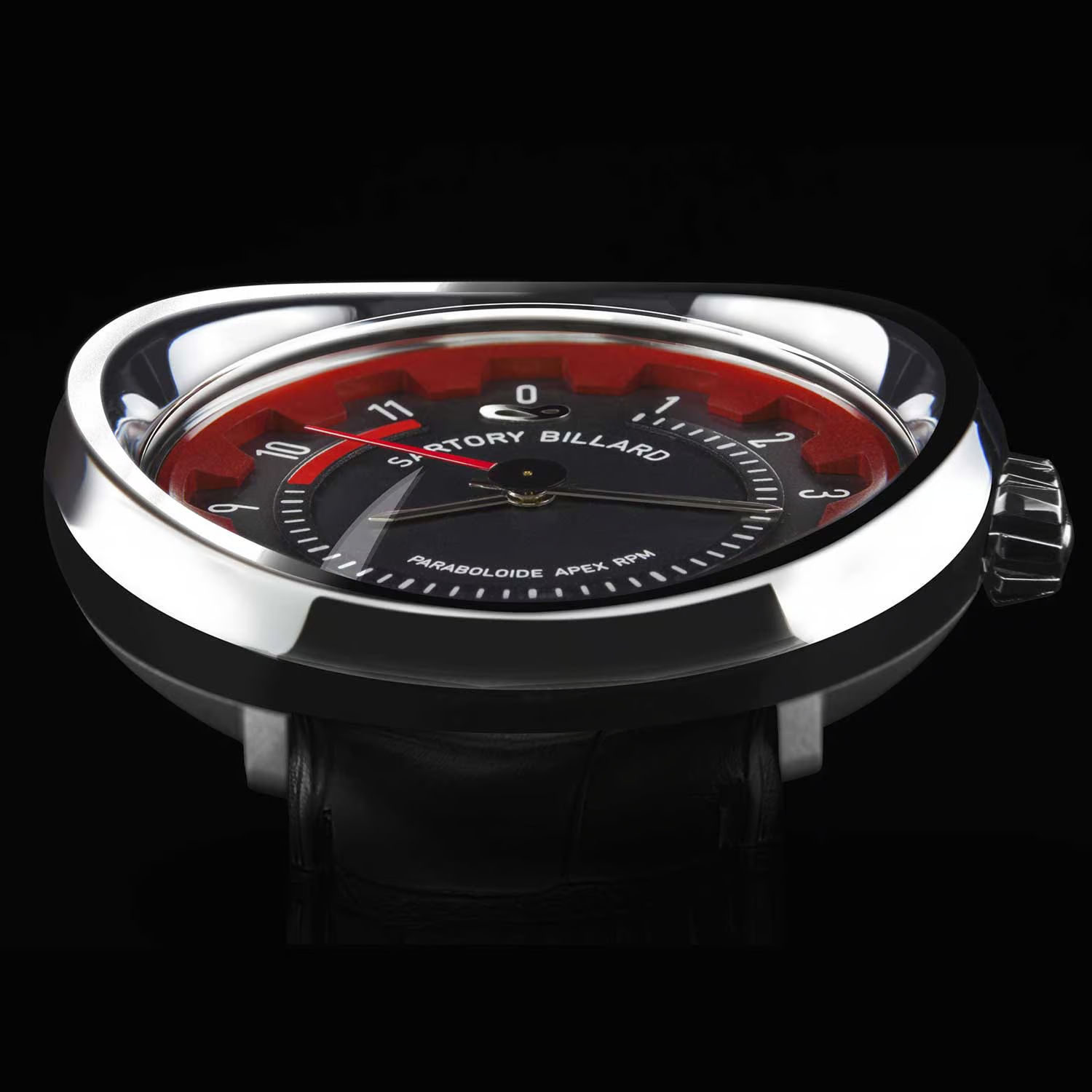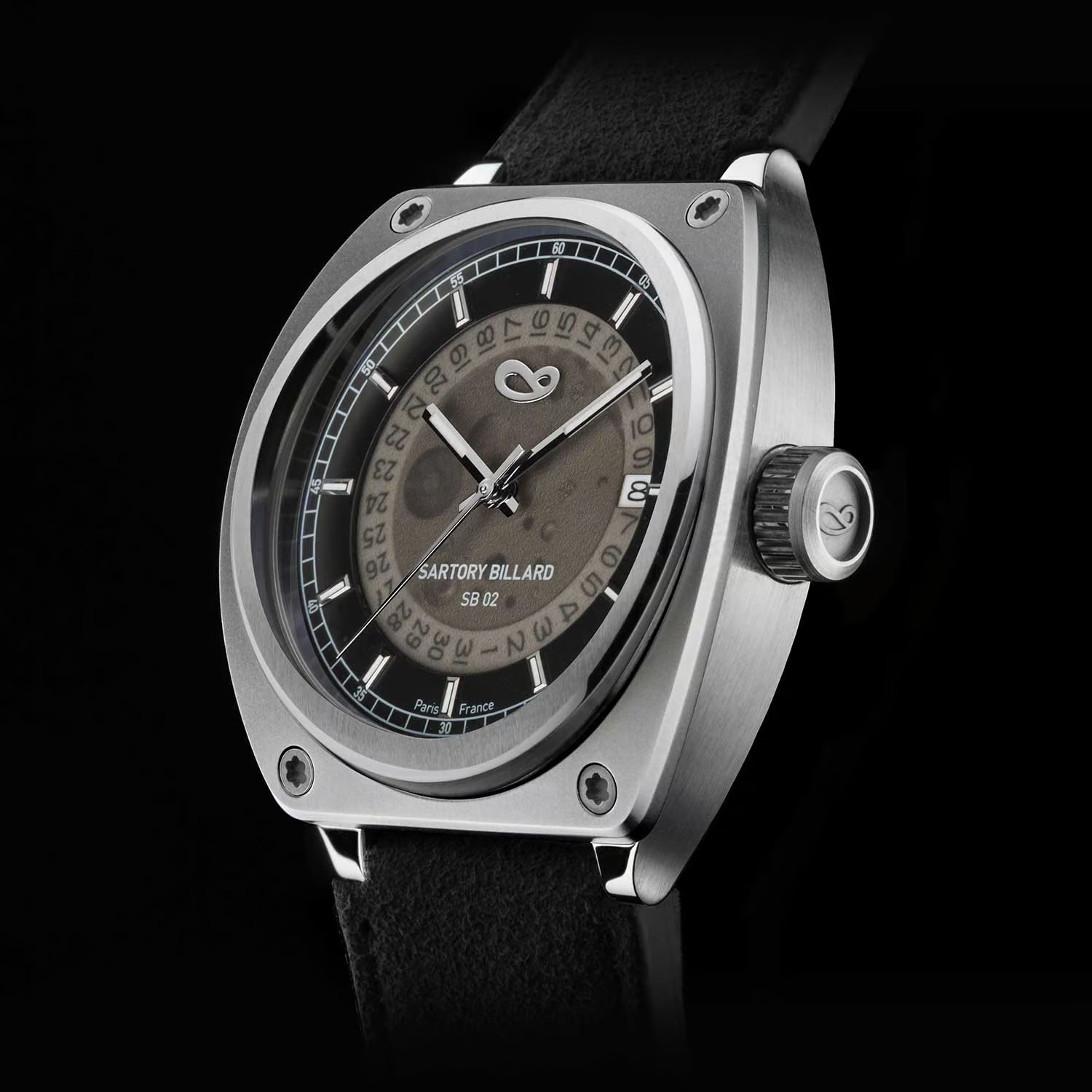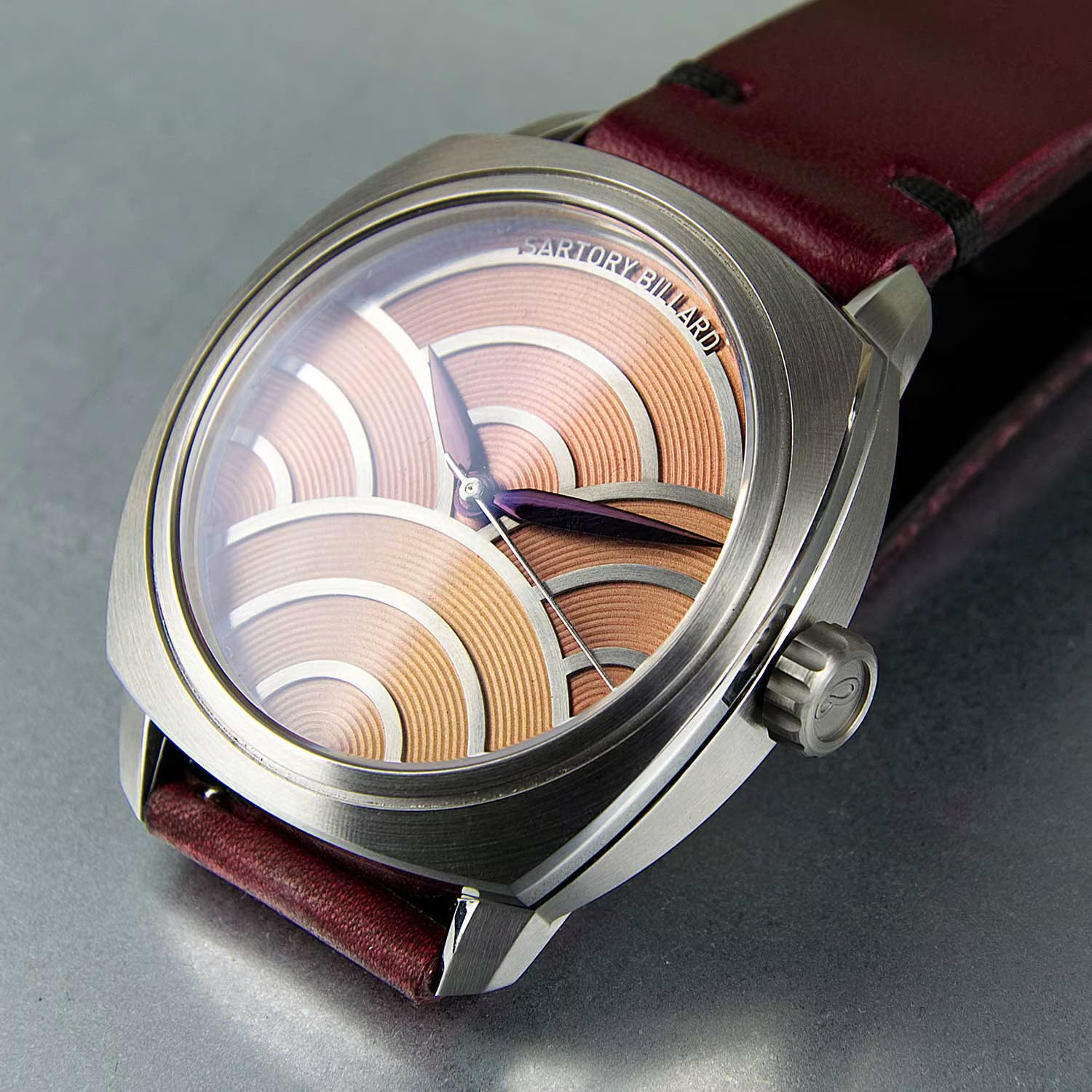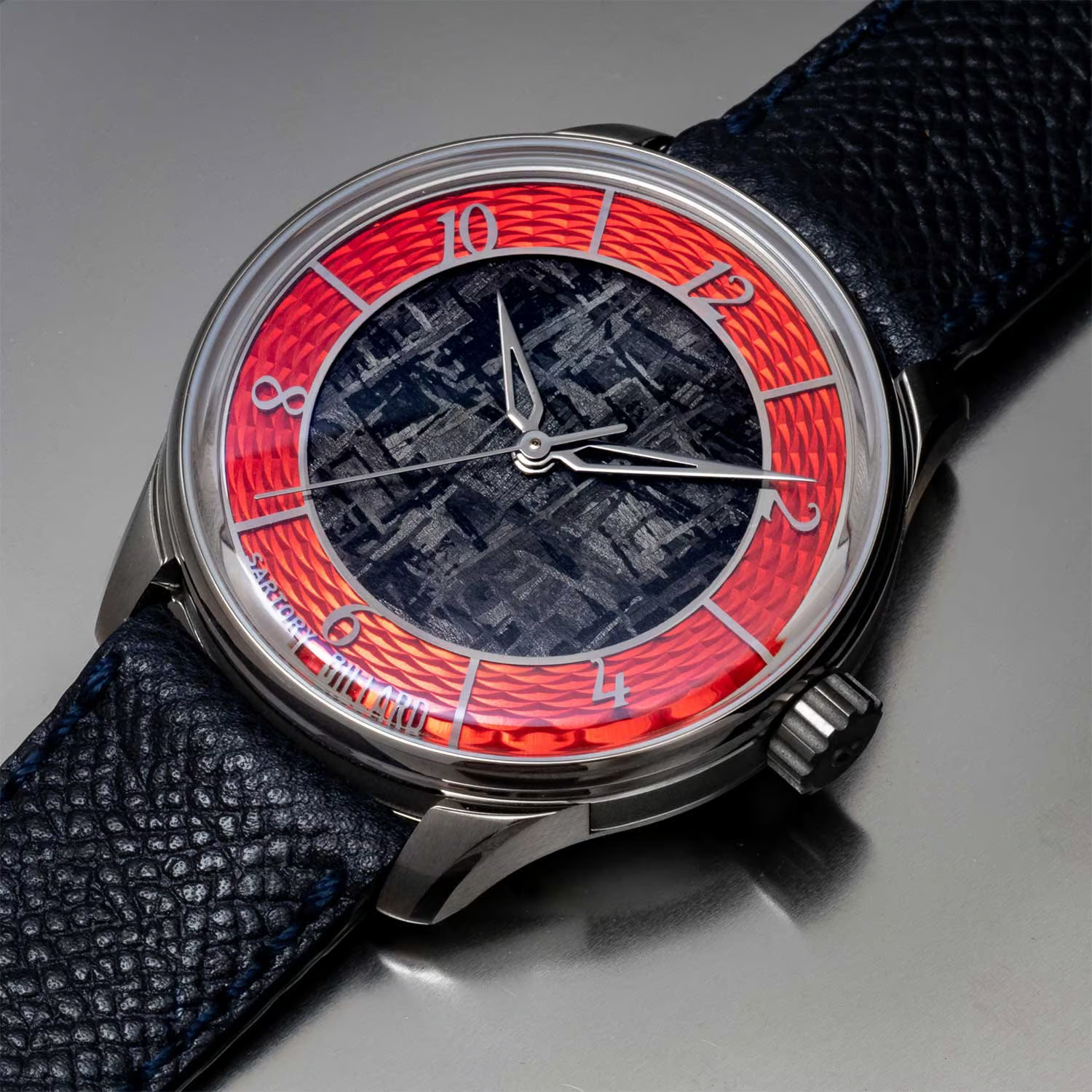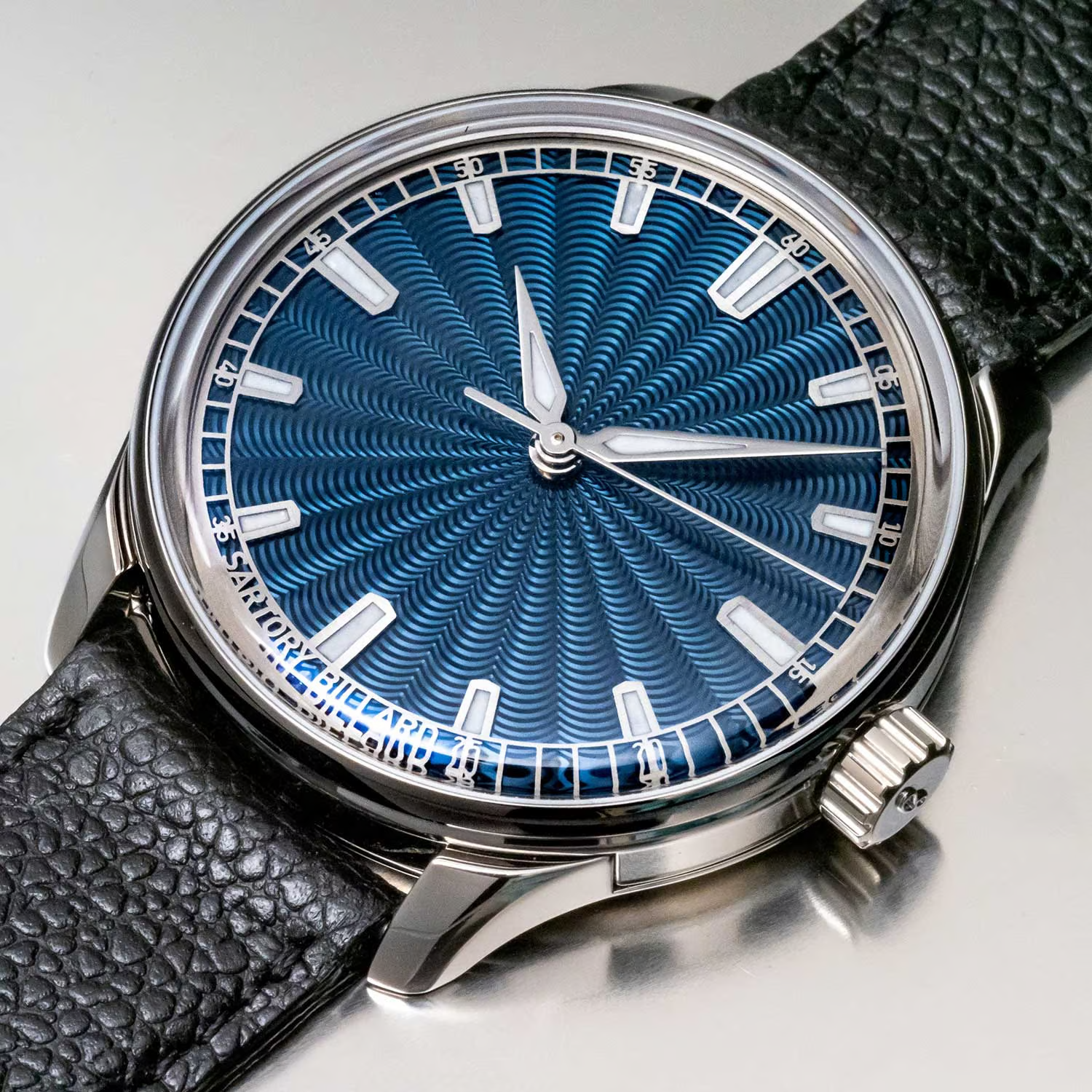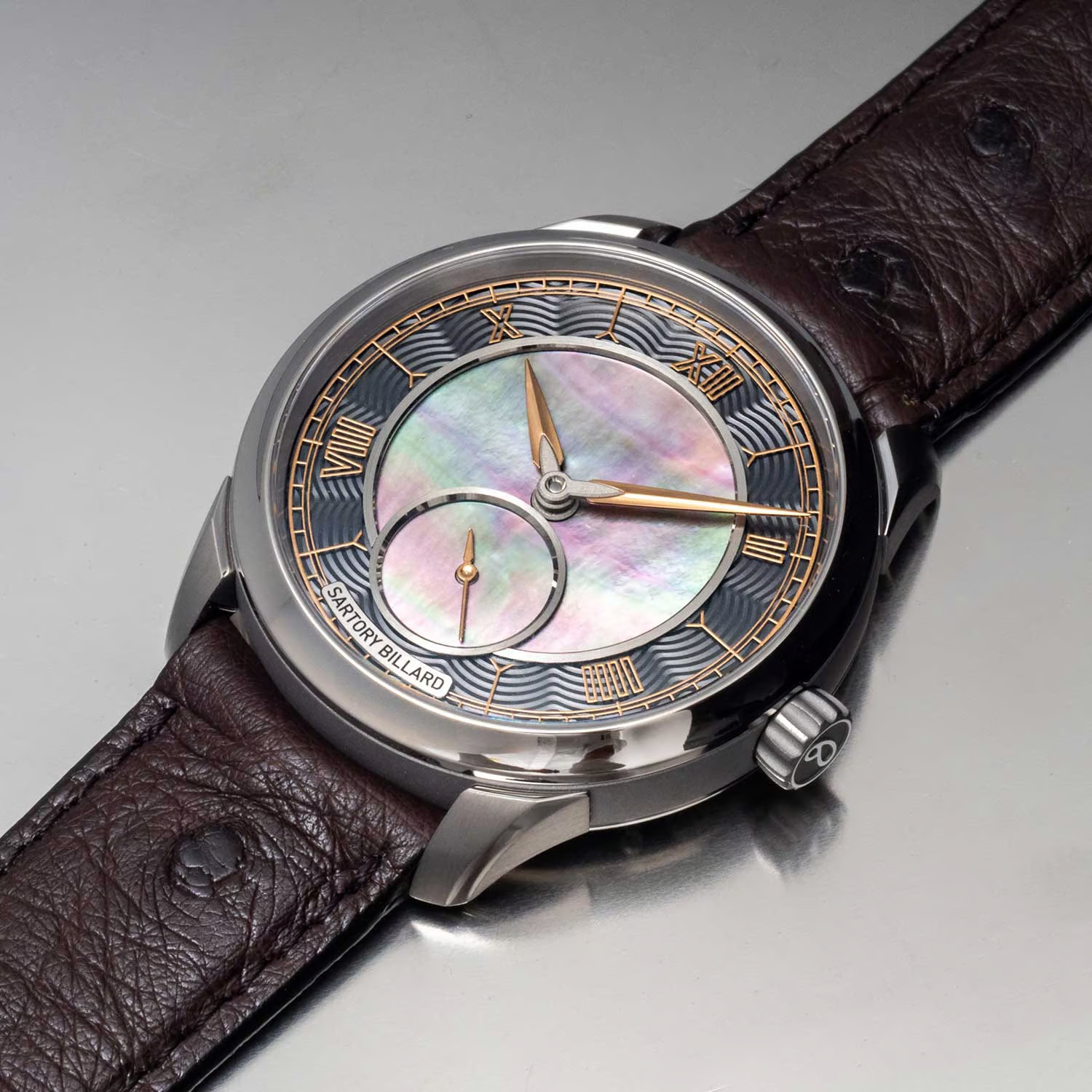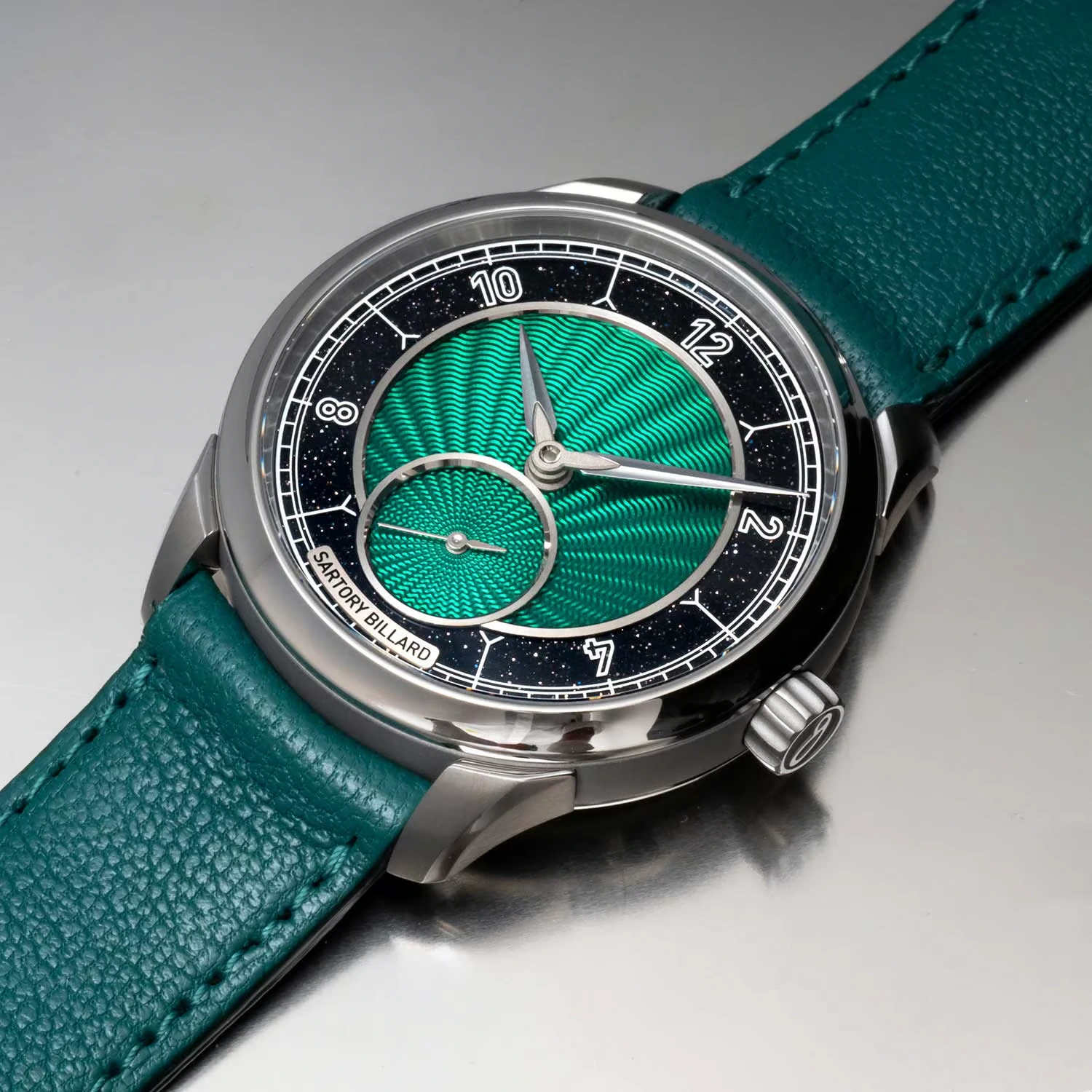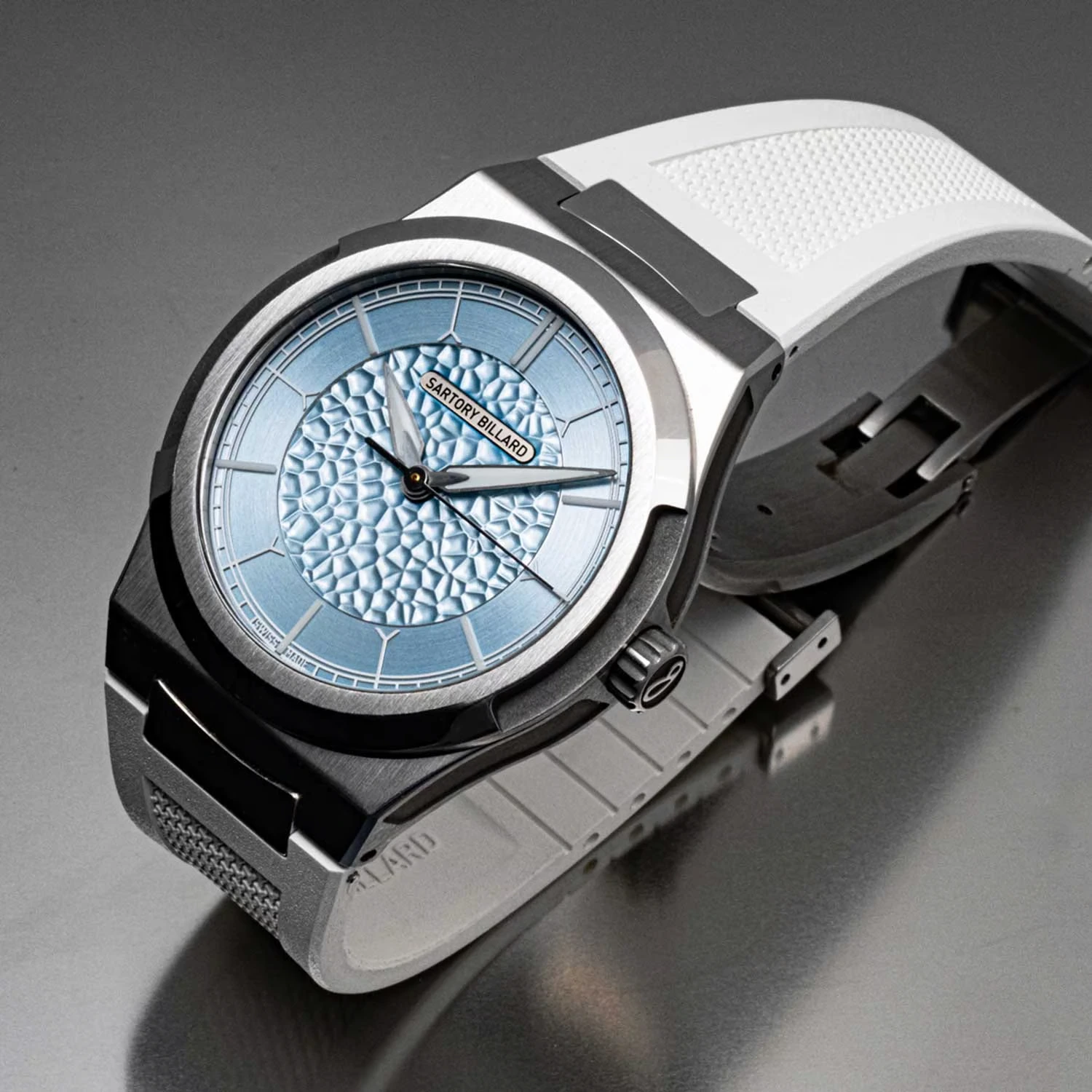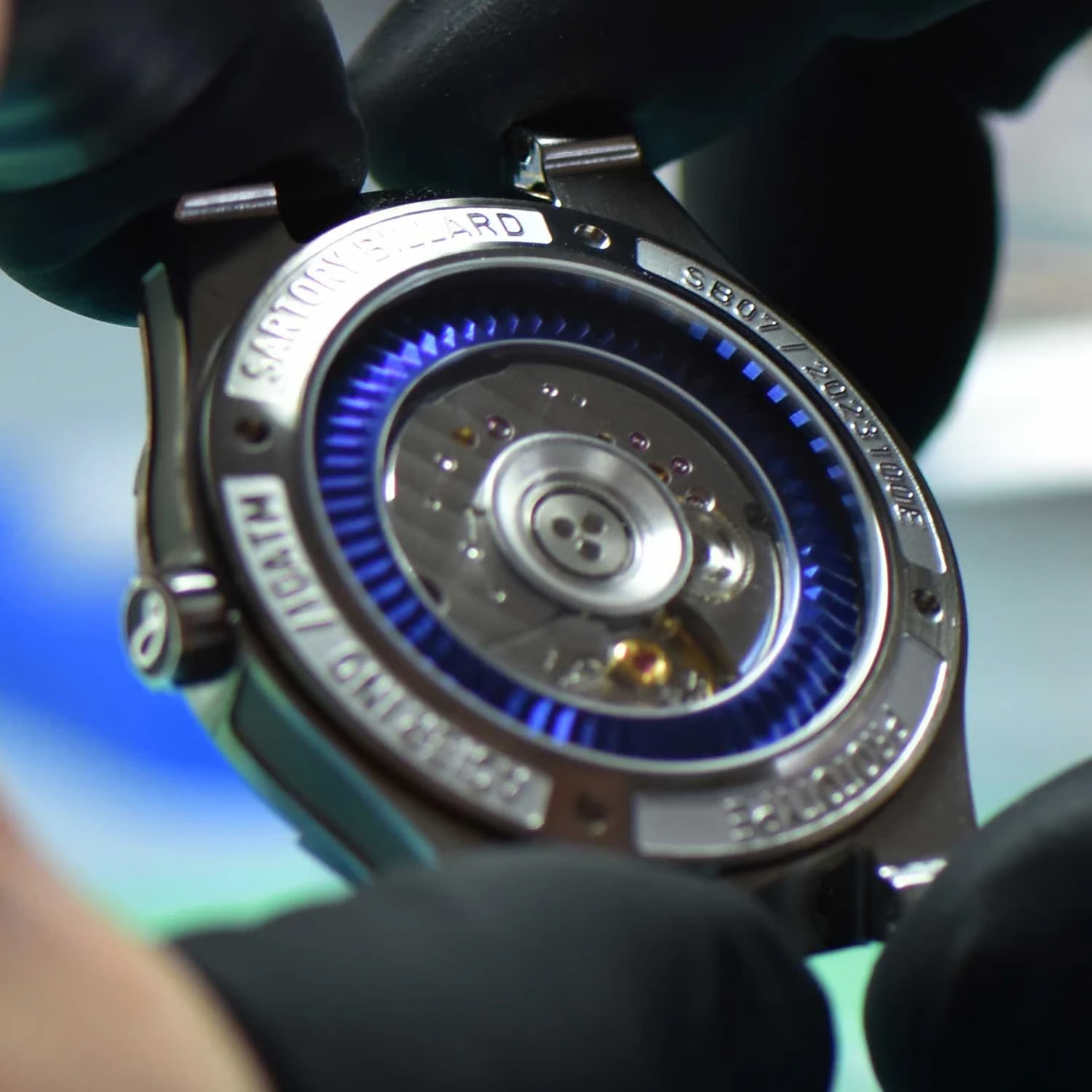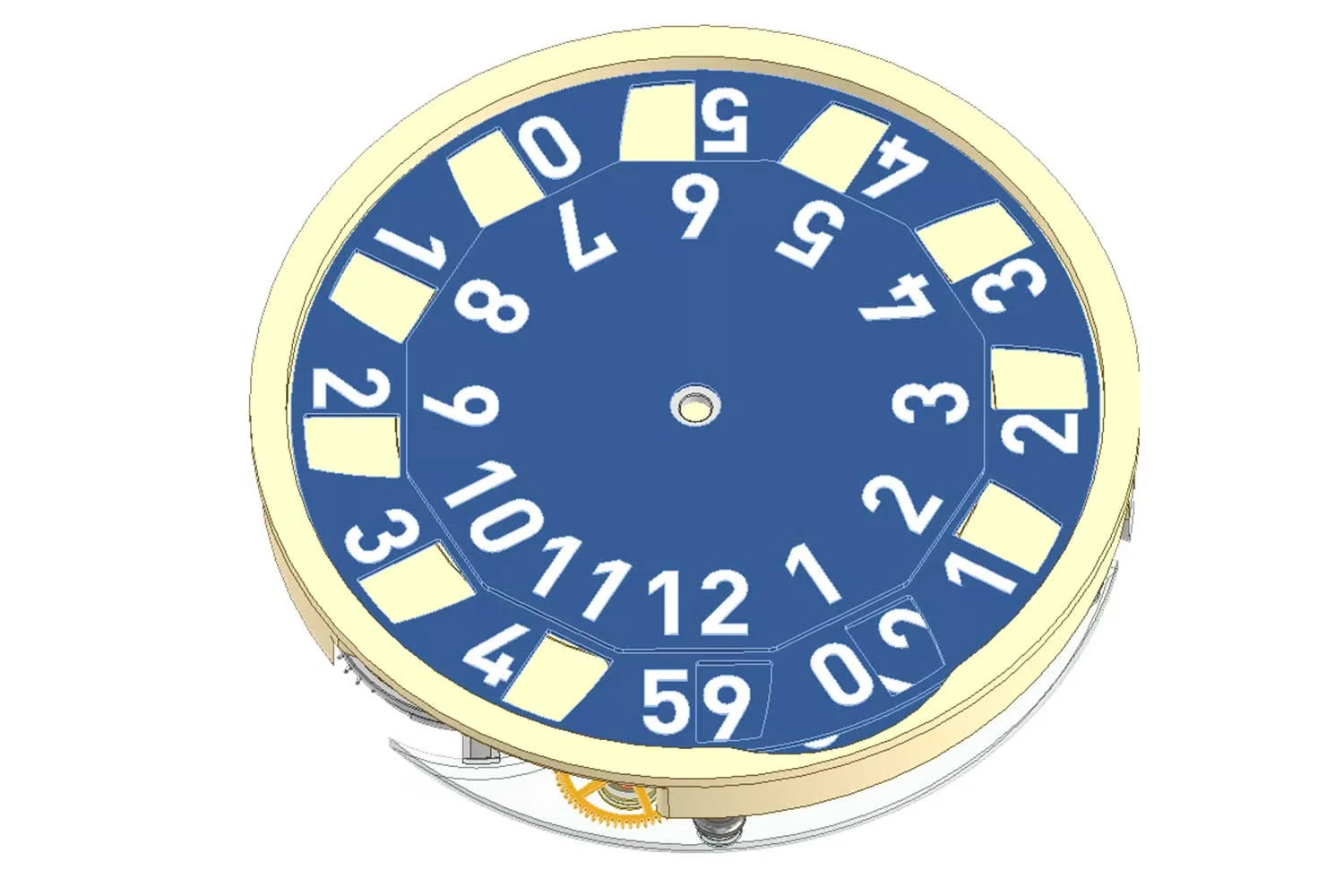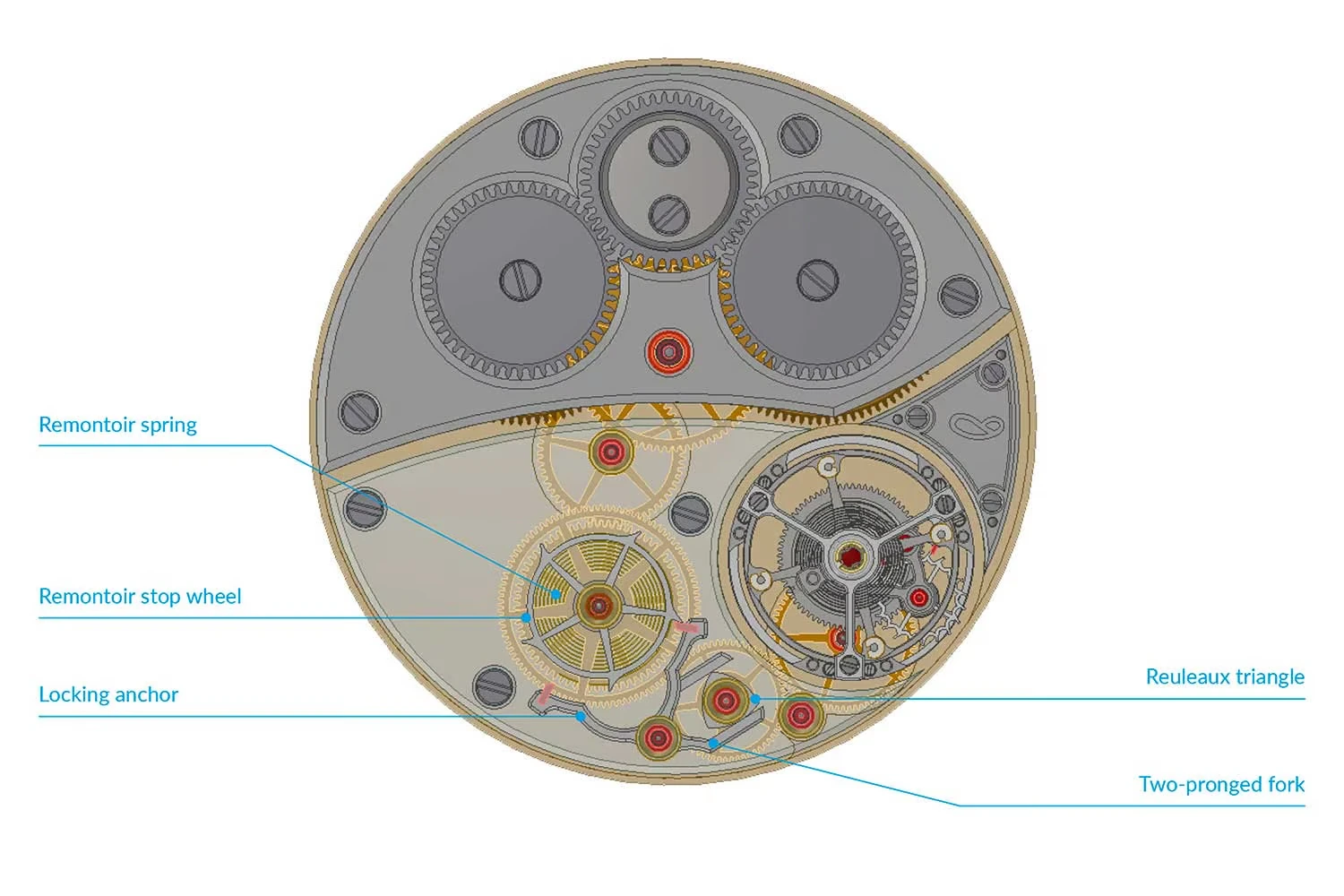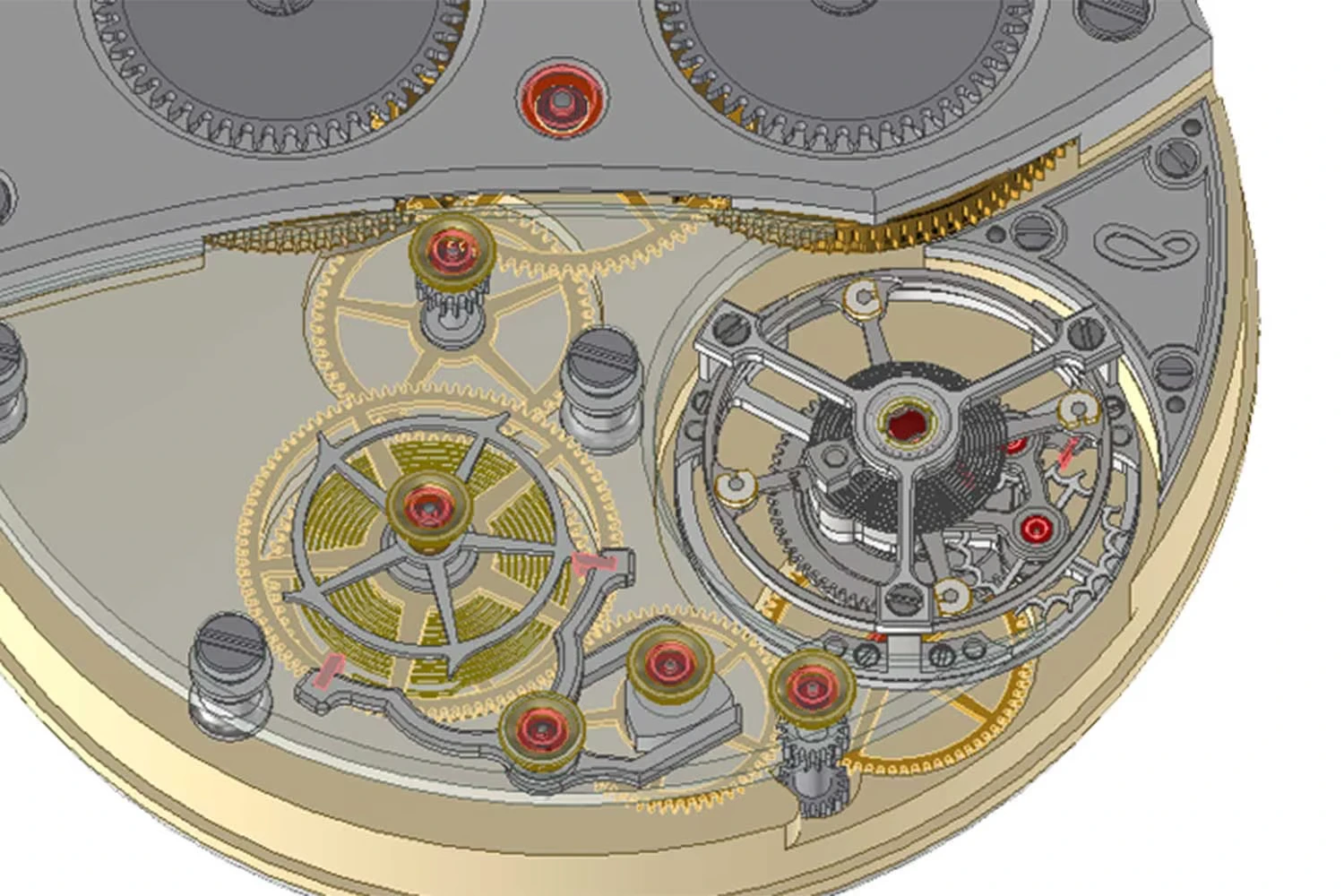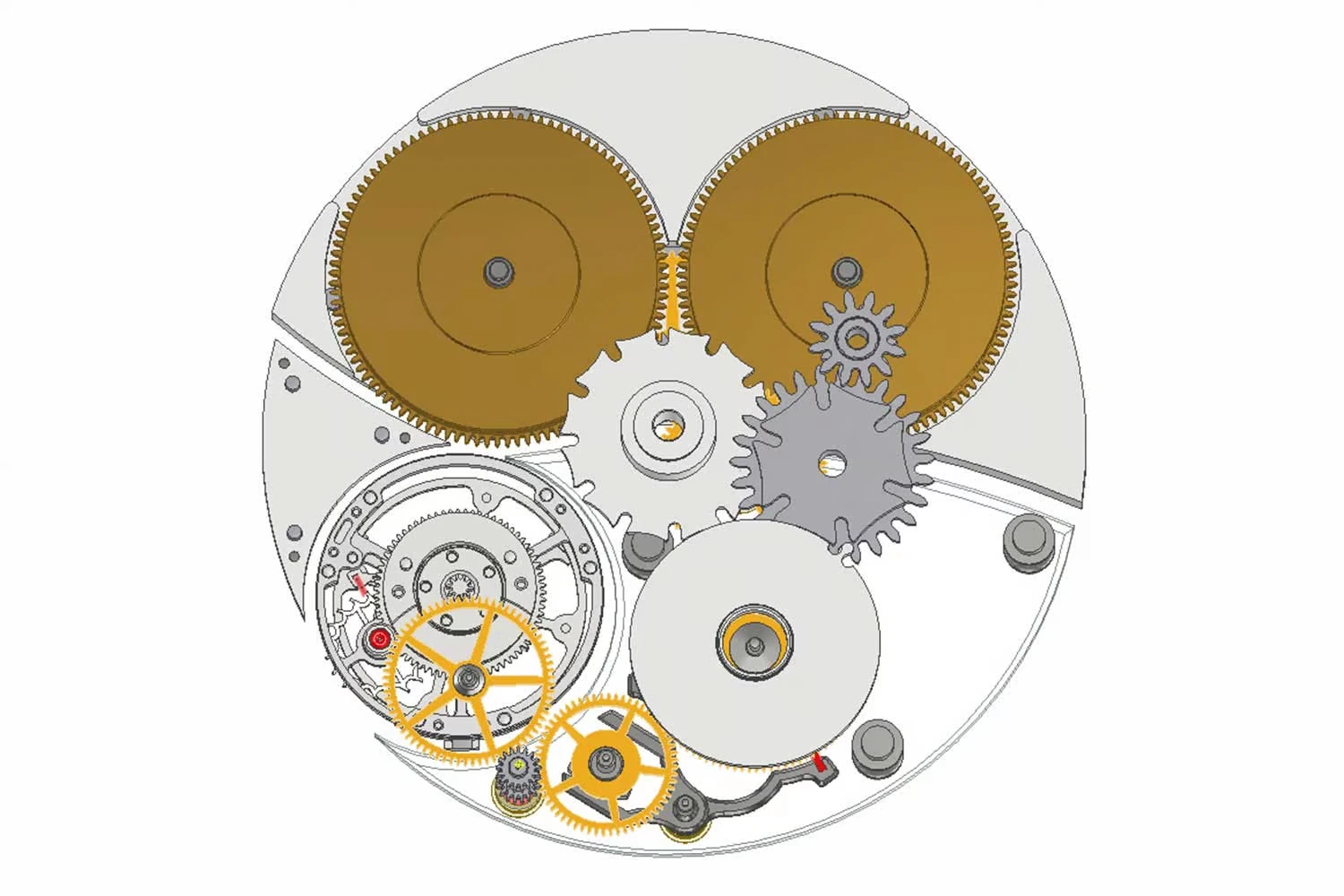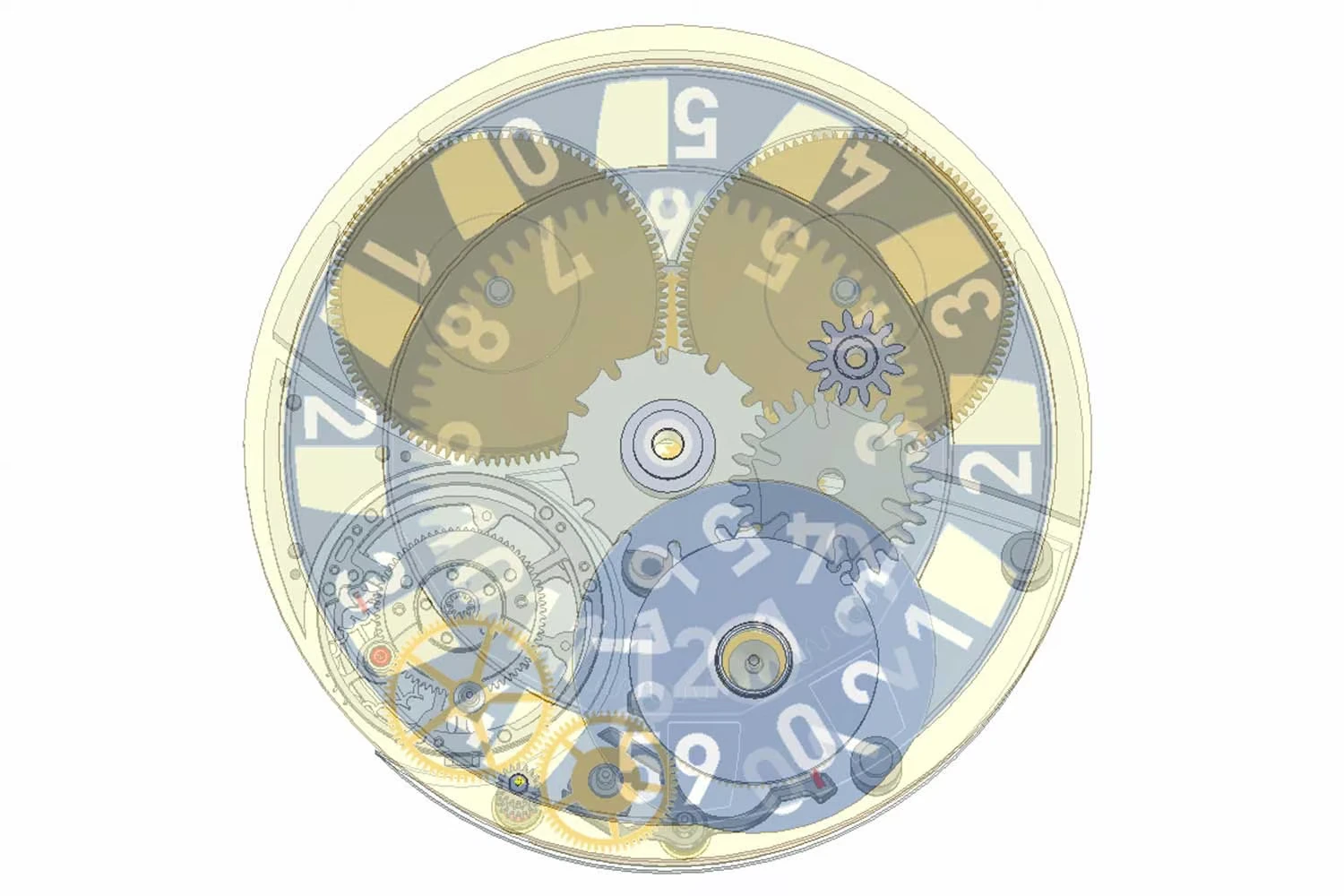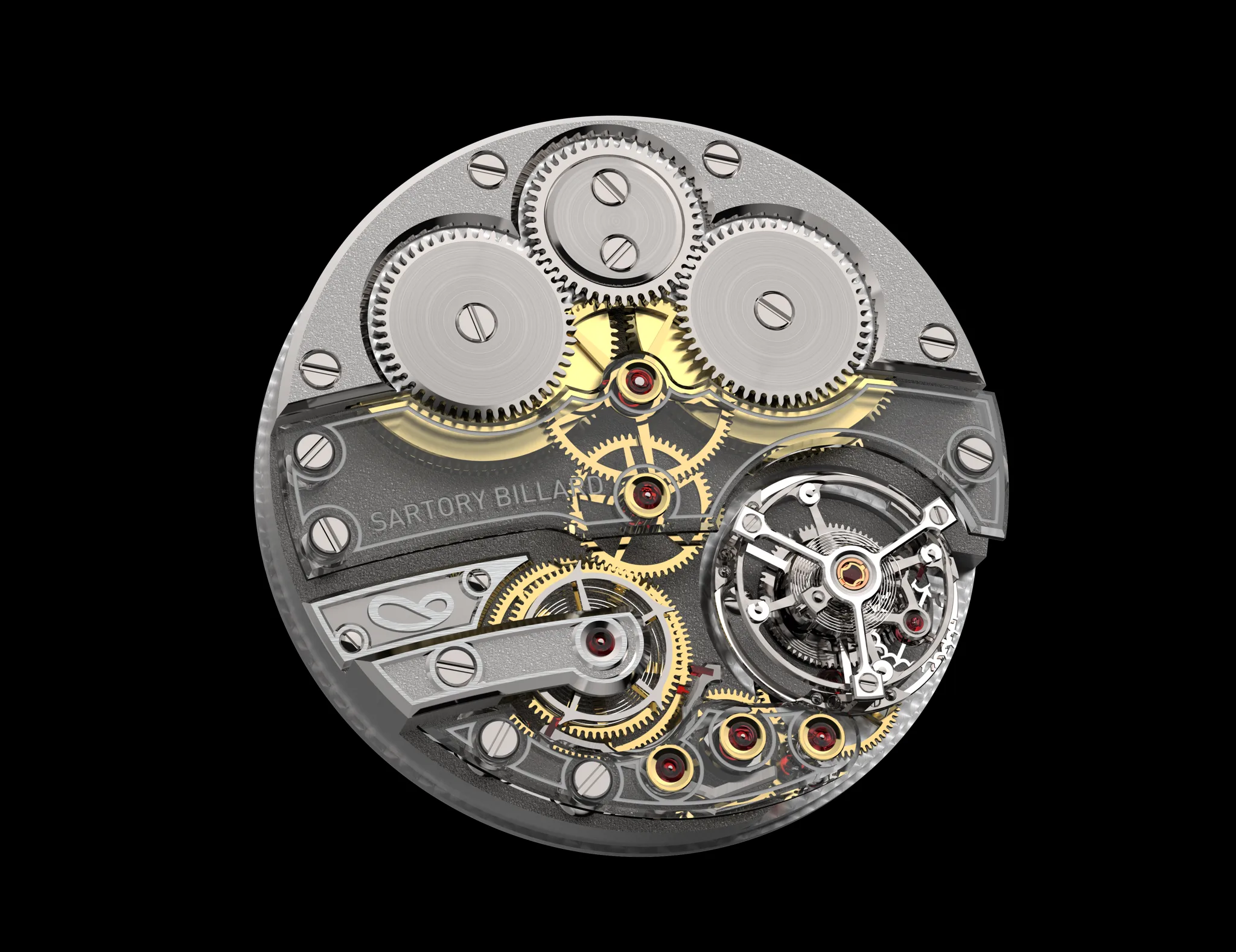SARTORY-BILLARD SB08
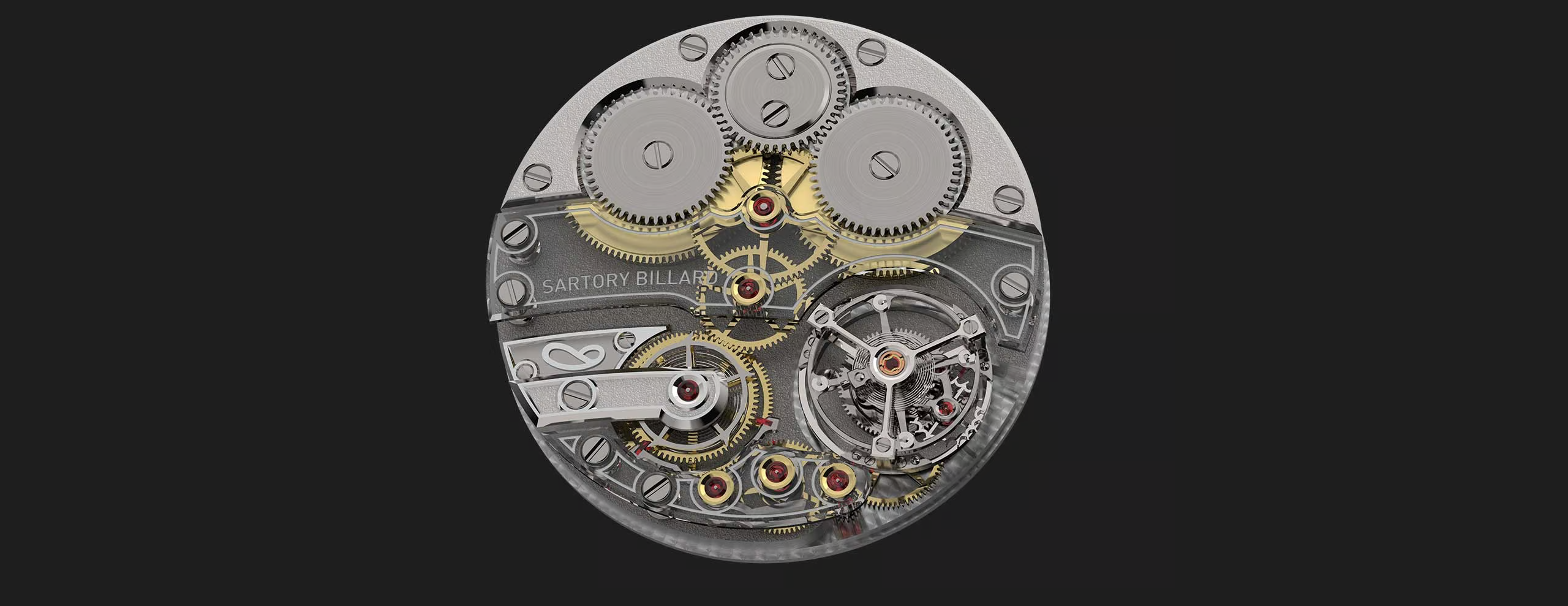
In the Making: Part 1 – Sartory Billard SB08 Jump Hour and Minutes with Tourbillon
Sartory Billard is best known for offering an incredible degree of customization and artisanal details on time-only watches that fall below the €10,000 mark. The brand’s breakout SB04 model along with the watches that followed have struck a harmonious chord with collectors, predicated on a formula of crafting exquisite external components that encase a dependable mid-range movement. This approach has yielded watches that not only offer an array of customization options but also remain within reach for a wide range of budgets. However, today, the brand is working on a tourbillon watch, and not just any tourbillon, but one that is highly sophisticated, incorporating a one-minute remontoir that powers three discs for a jumping hours and minutes display.
This marks a remarkable stride for the brand, and over the course of this three-part series, we will be documenting the design and development process up until its launch in 2024. Just as with any creative endeavour, it remains susceptible to modifications and fresh insights along the way.
The story so far
Sartory Billard was founded in 2015 by Armand Billard, an industrial designer and an owner of a design agency, whose work spanned a diverse spectrum, encompassing everything from computers and phones to goggles. His initial foray into wristwear came about when he designed tracking devices for a client, specifically tailored for individuals caring for someone with Alzheimer’s. Shortly thereafter, he, along with his friend Ludovic Sartory, had an idea to design a watch to mark their 40th birthdays, purely for their own enjoyment. While this may sound like a common pursuit in collector circles today, usually resulting in a customized watch, the duo ended up sourcing for suppliers and creating their own watch from scratch. This eventually led to the birth of his own business.
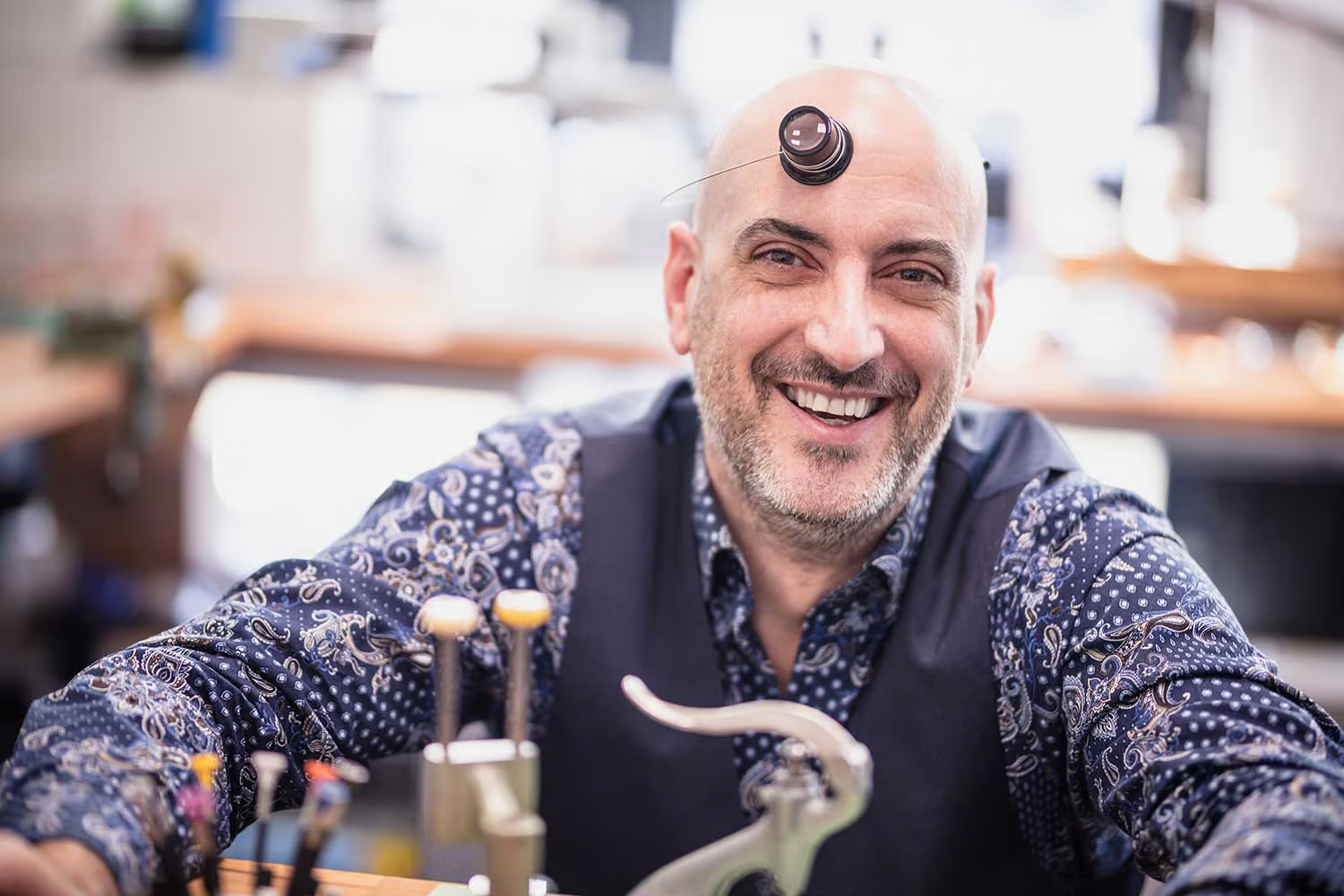
Armand Billard
His fascinating journey is one marked by trial and error, which when viewed in hindsight makes for a valuable blueprint for budding startups. Armand’s first three watches – the SB01, SB02, and SB03 – all featured unconventional case designs that bore witness to Armand industrial design expertise. While these cases had a unique charm, they had a niche appeal among collectors. Ludovic Sartory eventually withdrew from the venture after the various setbacks but Armand, on the other hand, sold his design agency in 2017 to devote himself completely into his next watch. By then, the essential ingredients were already present, the techniques just needed to be further honed and perfected.
For his fourth watch, the SB04, Armand shifted gears and channeled his focus on the dial’s artistry, while embracing the familiarity of a classic 40mm round case. The dial, which comprised of a simple but striking skeletonized chapter ring that was laser-cut, along with skeletonized hands, provided a canvas that allowed for a maximum degree of freedom in dial materials and decoration, all while retaining a recognizable aesthetic. Meanwhile, the 40mm case, while circular, adopted a clever three-part construction that allowed for three kinds of finishing – polishing on the bezel, sandblasting on the case middle and satin-brushing on the lugs which were integrated with the case back. Armand depended on Swiss suppliers for the case, but he had to personally acquire the skills and knowledge to manufacture the titanium dials, chapter rings, and hands by himself. Within the watch was an automatic central seconds movement, which was initially an STP calibre but has now transitioned to a La Joux-Perret movement. The price for a custom creation starts at €4,200. The SB04, as we know it, was a major hit and continues to be the brand’s best-selling model.
The orders kept him occupied in the following years as he worked on fine-tuning and elevating his proposition. Last year, he introduced the hand-wound SB05, a watch that is intrinsically more refined. While it still retained the distinctive chapter ring, the dial was now more complex, comprising of four components, each individually customizable: the chapter ring itself, an outer ring, an inlaid central piece as well as an inlaid small seconds subdial. The case was now more classically proportioned at 38.5mm and the movement within is the La Joux-Perret 7380 calibre with a 90-hour power reserve. It was followed by the SB07 this year, a sports watch with an integrated bracelet and once again, a fully customizable dial.
Armand’s path to this juncture is a testament to his extraordinary dedication and determination. Having gained a more profound insight into his clientele and the market, he is now venturing into complications, this time starting right at the top, with a highly sophisticated flying tourbillon movement.
The SB08
Armand’s commitment to transparency and openness extends beyond the design process itself. The manner in which he found a movement constructor for the SB08 was equally unconventional. Armand had designed a dial featuring a jumping hour and minutes display and, in a unique twist, he shared an image of it on Instagram, accompanied by a caption that read, “If you can create this movement, contact us.” He then got a response from Mathieu Cleguer, a 33-year-old movement constructor who has spent the last decade developing movements for a variety of brands such as Breva, Emile Chouriet and most notably Akriva, where he participated in the development of the renowned AK-06 movement. Since then, Mathieu has been designing and refining the SB08 movement.
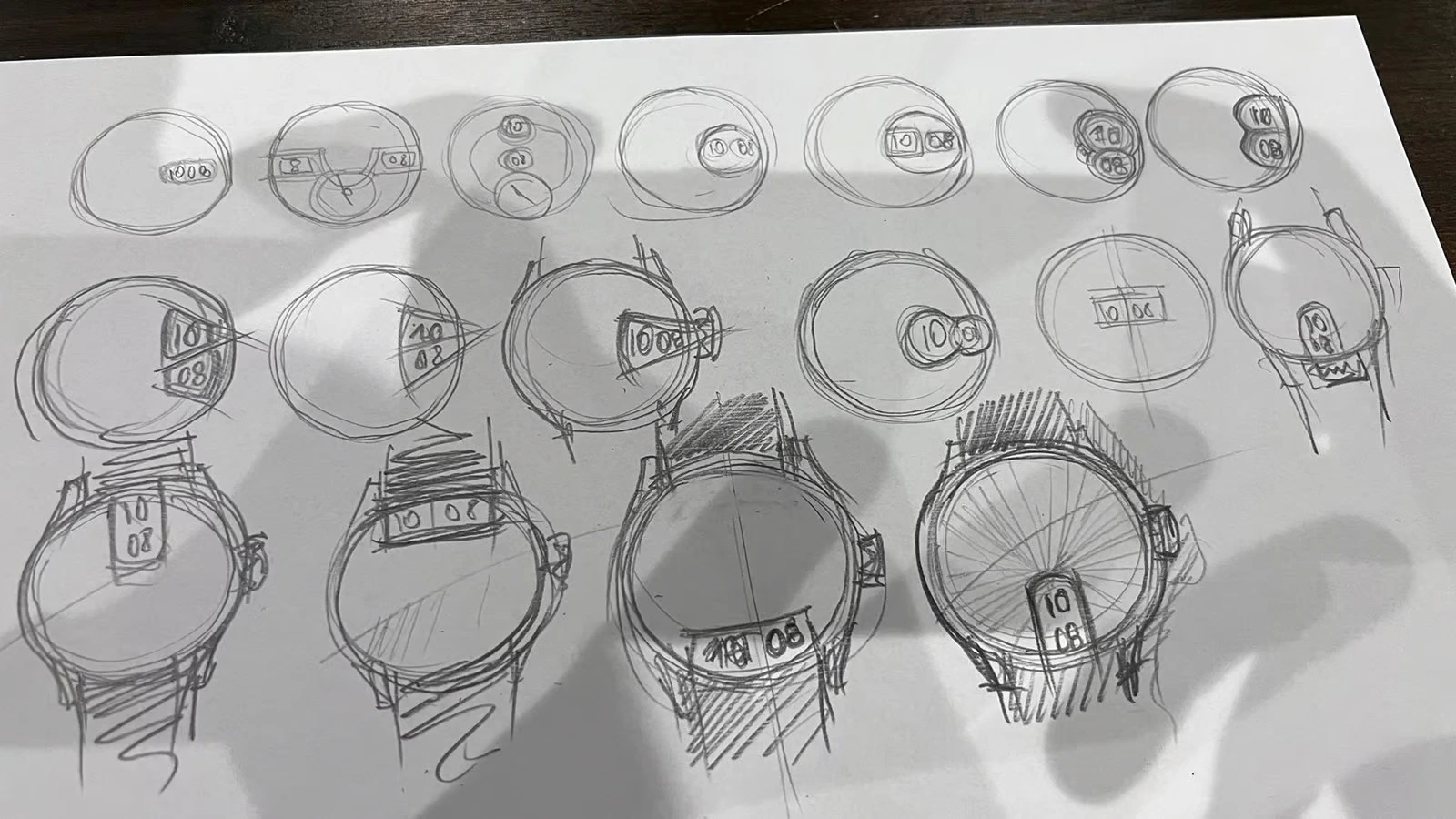
The initial sketches of the dial
To maintain the scope of customization, Armand decided on a digital hours and minutes display as this would free up a vast expanse of the dial and allow for a wide range of customization options, including miniature painting, gem-setting and guilloché. As such, the tourbillon, which is typically located in an aperture at six o’clock, is deliberately concealed.
The SB08 displays the time with three discs – hours, minute units and minute tens. The discs on which the numerals are printed represent significantly more inertia compared to a simple pair of hands. Hence, ensuring the simultaneous jump of all three discs, or at least one every minute, without negatively affecting balance amplitude or overall performance, presents a genuine challenge. This is addressed with the use of a 60-second remontoir which acts as a secondary store and source of power that provides constant energy to the balance.
The digital display consists of three discs of different sizes: the hour disc in the middle, a minutes tens disc on the periphery with apertures and a minutes units disc beneath
For the gear train to traverse the distance to the flying tourbillon, two additional wheels are incorporated into the going train and the remontoir is located on the third wheel in the gear train. The remontoir mechanism consists of a remontoir wheel, a stop wheel, a coil spring, a fork and locking anchor as well as a cam in the shape of Reuleaux triangle located on the fourth wheel.
The Reuleaux triangle revolves within a fork that moves back and forth while the triangle rotates. As the fork oscillates back and forth, the remontoir anchor, to which the fork is attached, mirrors this back-and-forth motion. As the fork moves, the anchor unlocks one of the teeth of the remontoir stop wheel. Each time the remontoir stop wheel, driven by the third wheel, snaps forward, it tensions the remontoir spring. The spring stores a full reserve of energy such that the remontoir wheel is able to drive the subsequent wheels and the flying tourbillon.
While a tourbillon was invented as a genuine aid to rate stability, it simultaneously introduces additional inertia and friction. This effect becomes more pronounced as the mainspring gradually winds down, leading to a drop in balance amplitude. Thus, the remontoir also serves to overcome the weight and rotation of the tourbillon cage. As such, the remontoir coil spring is much larger than the average to handle a far greater load.
In addition to delivering constant torque, the remontoir also functions as a switching device, triggering the jump of the minute tens and hour disc. A finger cam, to which the minute unit disc is affixed, is mounted on the pivot of the remontoir wheel on the dial side. As it completes a full rotation, it advances a six-arm Maltese cross that is attached to an intermediate wheel. This intermediate wheel then drives a smaller wheel that advances the minute tens disc. As the Maltese cross completes a full rotation in an hour, a pin on the intermediate wheel advances a 12-arm Maltese cross in the centre and the hour disc attached to it leaps forward.
As the watch combines two power-intensive complications that are dependent on the amount of stored energy in the remontoir, the movement is designed with double barrels. Additionally, the use of two mainspring barrels allows the mainsprings to be thinner and lighter, reducing the likelihood of the coils sticking together as lubrication thickens with age. Mathieu explains that due to the lack of hands on the second gear, they have more freedom in terms of how the power source can be configured. They can either be installed in a series and unwind faster to compensate for torque demands or in parallel to increase power density. Naturally, a parallel configuration offers a more favorable balance between the number of turns and torque output.
The movement was initially designed such that the crown wheel, barrels, and the first wheel in the gear train are supported by a bridge while the rest of the gear train are sandwiched between the base plate and a top plate made from sapphire crystal, which are held together by pillars. However, Mathieu has further refined the design. The first two wheels in the gear train are now supported by a sapphire top plate while the remontoir stop wheel has its own bridge, which lends itself to anglage. Below, the locking anchor, fourth wheel and pinion are held in place by a slim sapphire bridge, enabling a clear view of the remontoir mechanism in action. The base plate and barrel bridge have a frosted finish while five jewels in the movement have corresponding gold chatons. As the tourbillon is a flying tourbillon, it is only supported from below and has no upper bridge.
Work in progress
The case of the watch has been planned for 41mm with a thickness of 11.5mm. As these are early stages, technical details regarding the movement such as materials, power reserve, frequency and even bridge design and finishing are not finalized. If challenges arise, considering the inherent complexity in achieving the right amount of power to drive three discs of different sizes at different intervals and in different configurations, or should better ideas emerge during the process, the design remains open to modifications and improvements. The team welcomes input and feedback as they continue to refine all aspects of the watch.
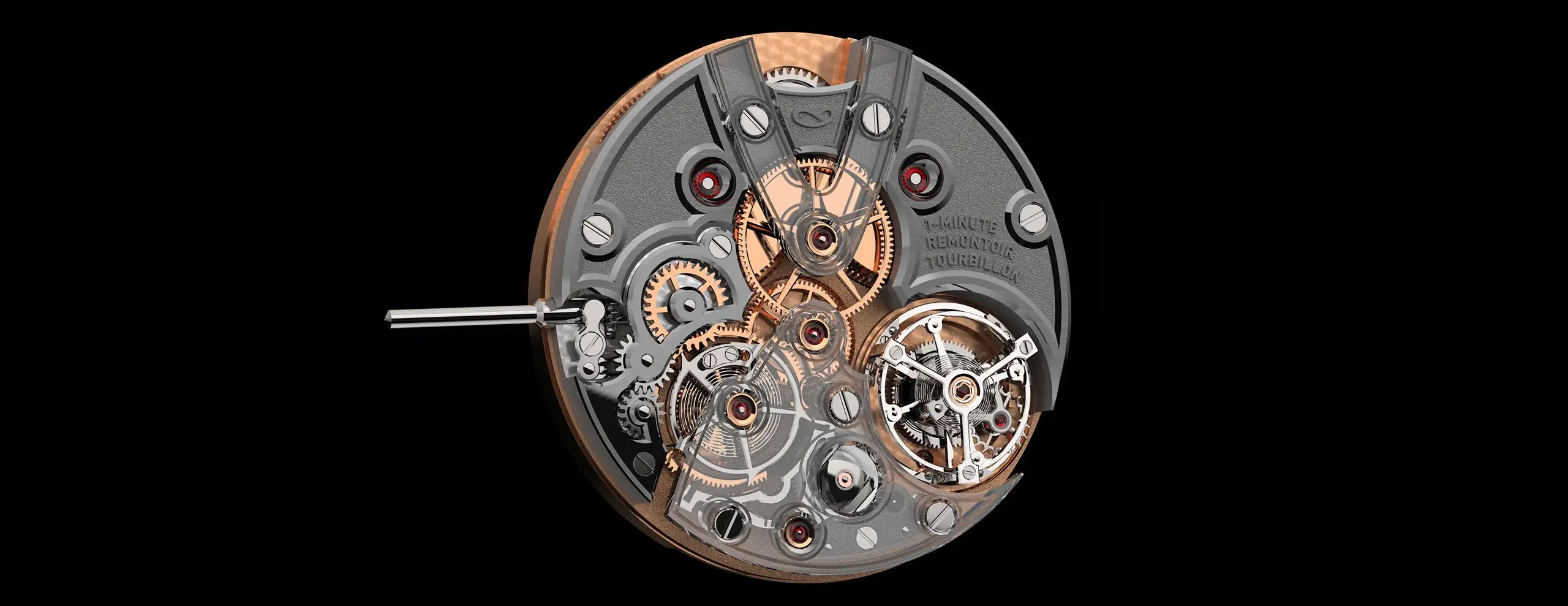
In the Making: Part 2 – Sartory Billard SB08 Jump Hour and Minutes with Tourbillon
Having begun on a journey to create a highly complex jump hour and minutes tourbillon watch a year ago, Sartory Billard is currently in the advanced stages of the design process, where both the dial and movement are almost finalised.
To recap in brief, after designing an array of remarkably successful, fully customisable time-only watches, namely the automatic SB04, the hand-wound SB05, and the SB07 sports watch, Armand Billard decided it was time to venture into the realm of complications. At the tail end of last year, the brand unveiled its first tourbillon watch – the SB06 Flying Tourbillon, which was a project that stemmed from a request by Cronotempvs, a private collector’s club in Spain. For the SB08, Armand decided on a digital hours and minutes complication, a choice intended to liberate a considerable expanse of the dial for personalized customization.
Watches with jumping displays, as it is, present significant challenges for watchmakers as discs are much heavier than conventional hands, which not only affects power reserve but also leads to a drop in amplitude, particularly when all three discs advance simultaneously at the top of each hour. However, the SB08 is also a tourbillon, which makes things far more complicated in terms of power management. In fact, this is the first-ever tourbillon watch with both jumping hour and minutes. To do this, Armand enlisted the help of movement developer Mathieu Cleguer.
In Part 1 of the series we ran, Mathieu had designed the movement with the crown wheel positioned at 12 o’clock, driving two parallel mainspring barrels. The gear train powers a remontoir that releases energy to power the jump of at least one disc each minute as well as drive the rotation of the tourbillon. The minutes unit disc is mounted directly on the pivot of the remontoir wheel, sequentially triggering the jump of the minutes tens and hour discs through a system of Maltese crosses.
Since then, the entire construction has evolved substantially, with notable refinements and developments, particularly in the areas of hand-setting and bridge design.
Fundamental changes in construction
Originally, the jumping display, which consists of Maltese crosses and three discs, was intended to be located on the dial side of the base plate. But for ease of assembly and adjustment, Mathieu decided to separate the chronometry part of the movement from the jumping display. As such, the jumping display is assembled on a separate plate beneath the dial and is connected to the base plate via a pinion that drives the minutes units disc directly.
Initially, the crown was intended to be positioned at 12 o’clock for symmetry. However, the team later opted to relocate the crown to the traditional three o’clock position. This was driven by a desire to infuse a sense of classicism into what will be a largely contemporary design, as well as to ensure ergonomic winding. Additionally, this also ensures the winding stem will be closer to the minutes units disc (more on that later).
However, the process of moving the crown to three proved to be far easier said than done and it took numerous revisions to arrive at the final design. Initially, Mathieu decided to essentially rotate the movement by 90° such that the barrels now occupy the left half of the movement. At the same time, he had to make adjustments to the layout of gear train to visually optimise the available space that is now present at the bottom right quadrant of the movement. In the initial design (1A), he brought the tourbillon inward from the edge and added two co-axial, intermediate wheels before the remontoir wheel to occupy the empty space at the bottom right quadrant.
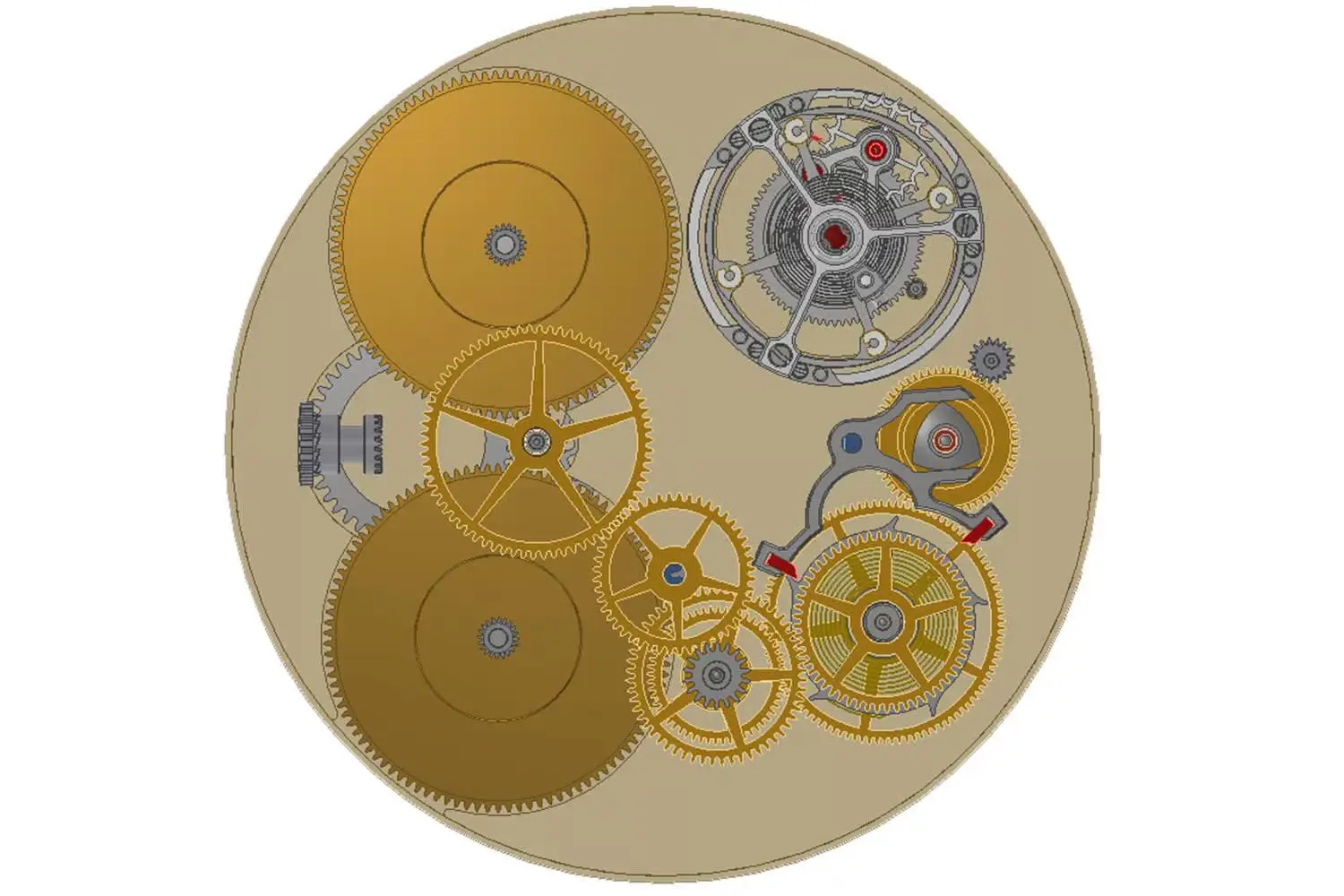
He also reconfigured the remontoir anchor and fork to reside further inside the movement, rather than at the edge. However, in this design, the co-axial wheels overlap the barrel and limits the height of the remontoir mechanism on the next axis. This was addressed in the next two designs (1B & 1C) in which he centralised the second and third wheels in the going train.
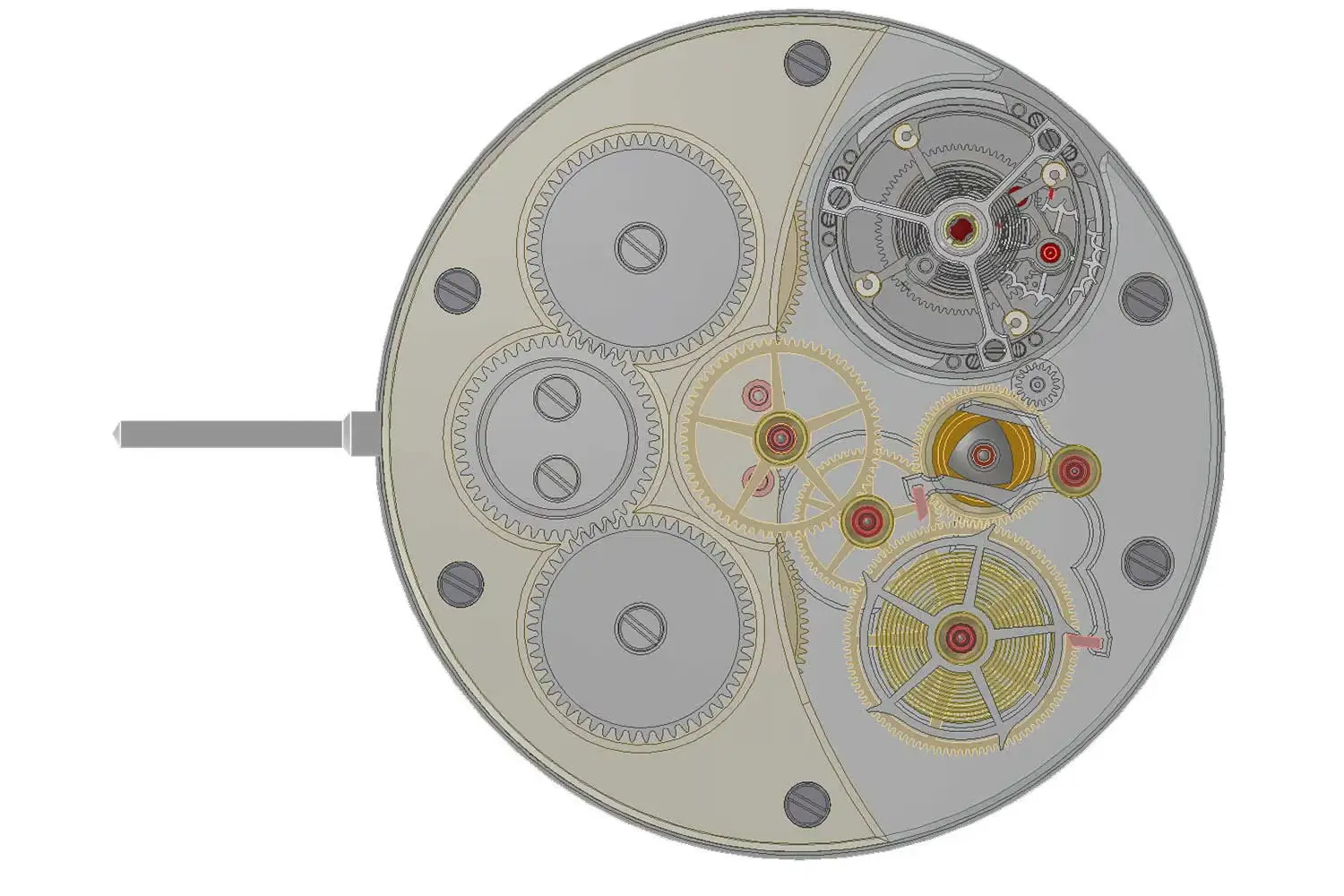
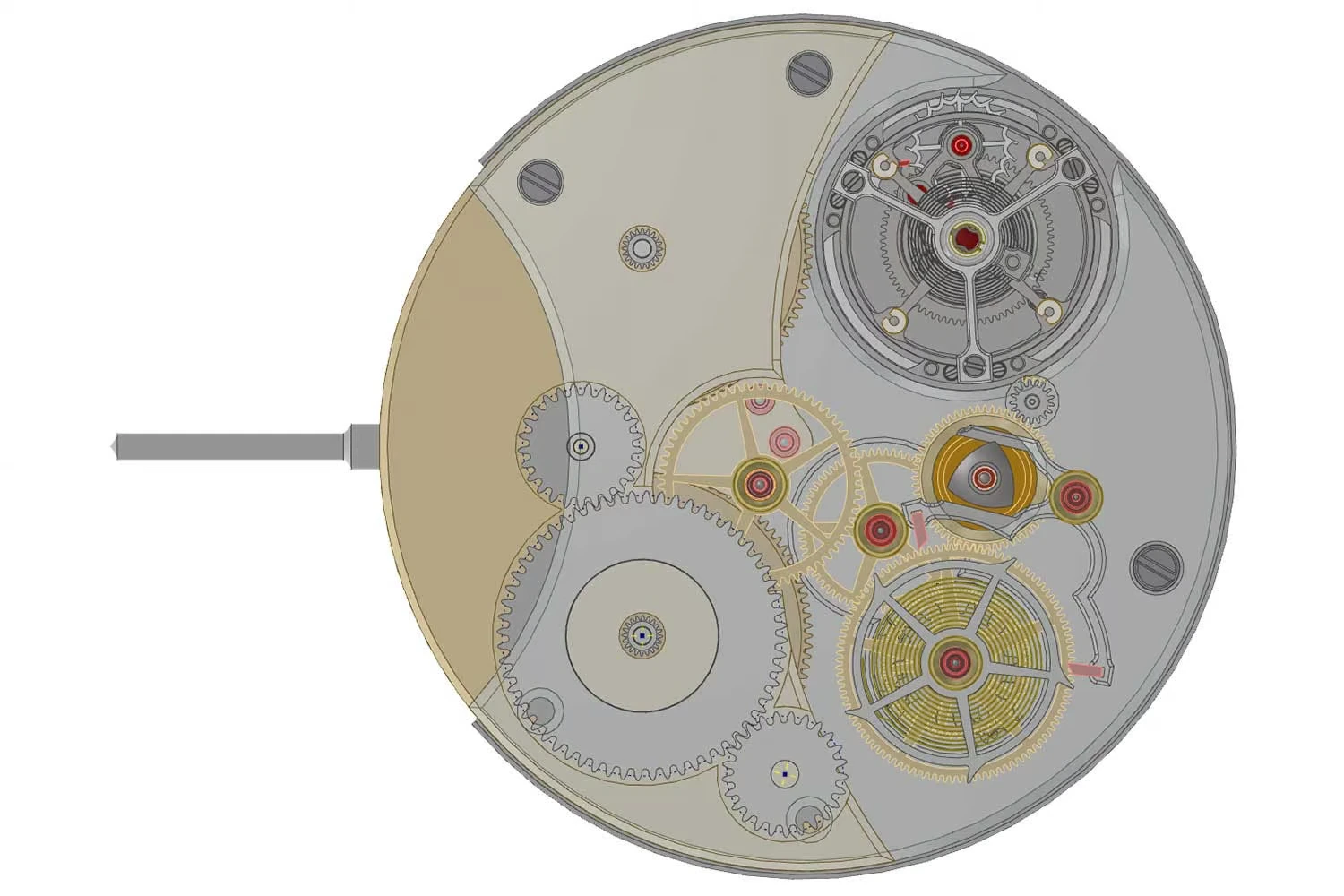
However, a more significant challenge arose when designing the time-setting mechanism. In a watch with conventional hands, time can be adjusted when the sliding pinion comes into contact with the minute wheel in the motion works via an intermediate wheel. However, in this case, the intermediate wheel has to be connected to the pinion of the minute units disc, which is too far away. A long and convoluted train of wheels had to be introduced to traverse the distance.
Additionally, during time-setting, the remontoir has to be isolated to ensure precise adjustment. Consequently, the minutes units disc can no longer be affixed to the pivot of the remontoir wheel. At the same time, Armand and Mathieu both felt that vertical symmetry is visually more compelling than horizonal, and they returned to where they started.
In the final design, the barrels are located at the top of the movement. They are mounted lid up from the bridge side with the ratchet wheels located beneath. As such, the crown wheel is also located on the dial side of the movement.
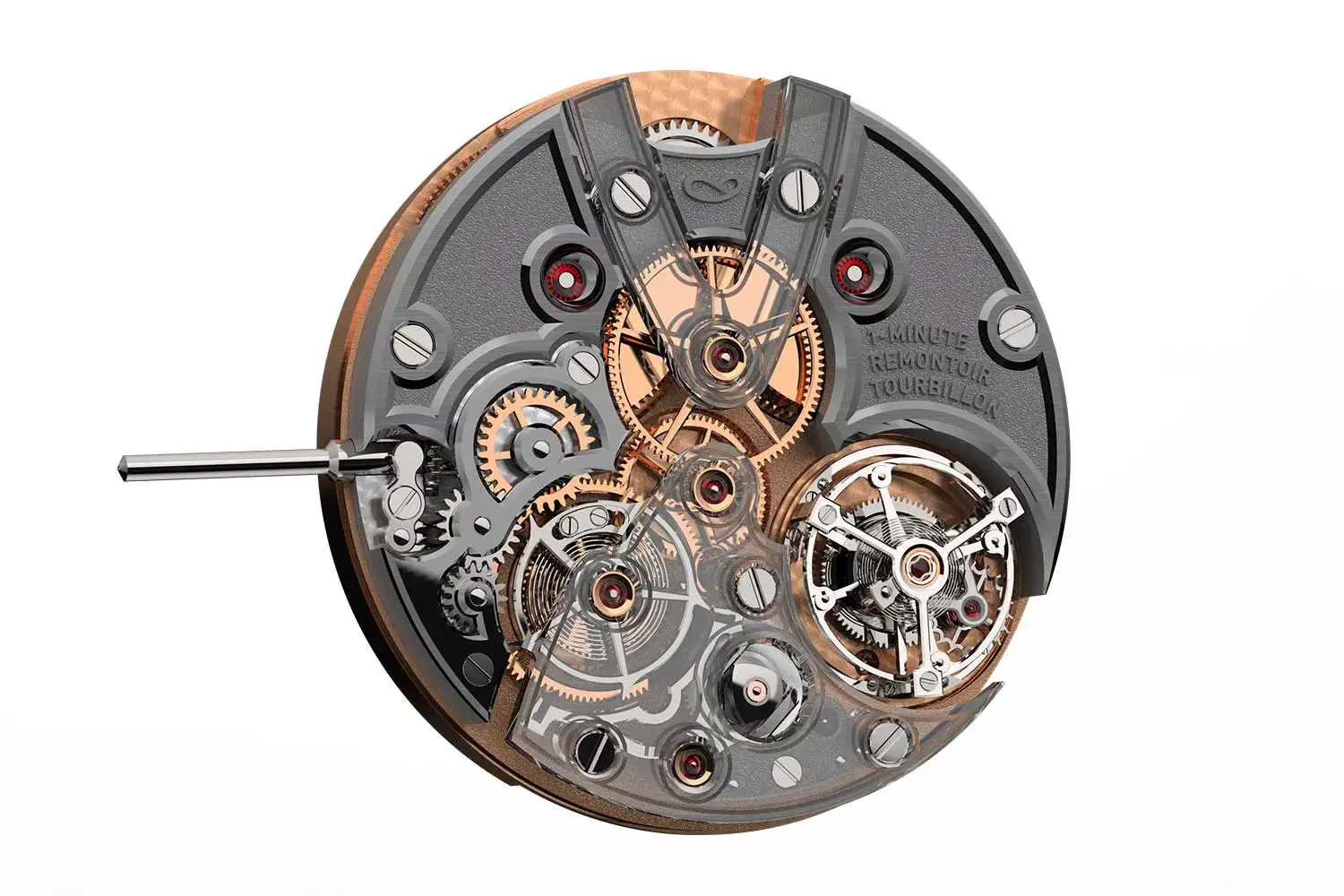
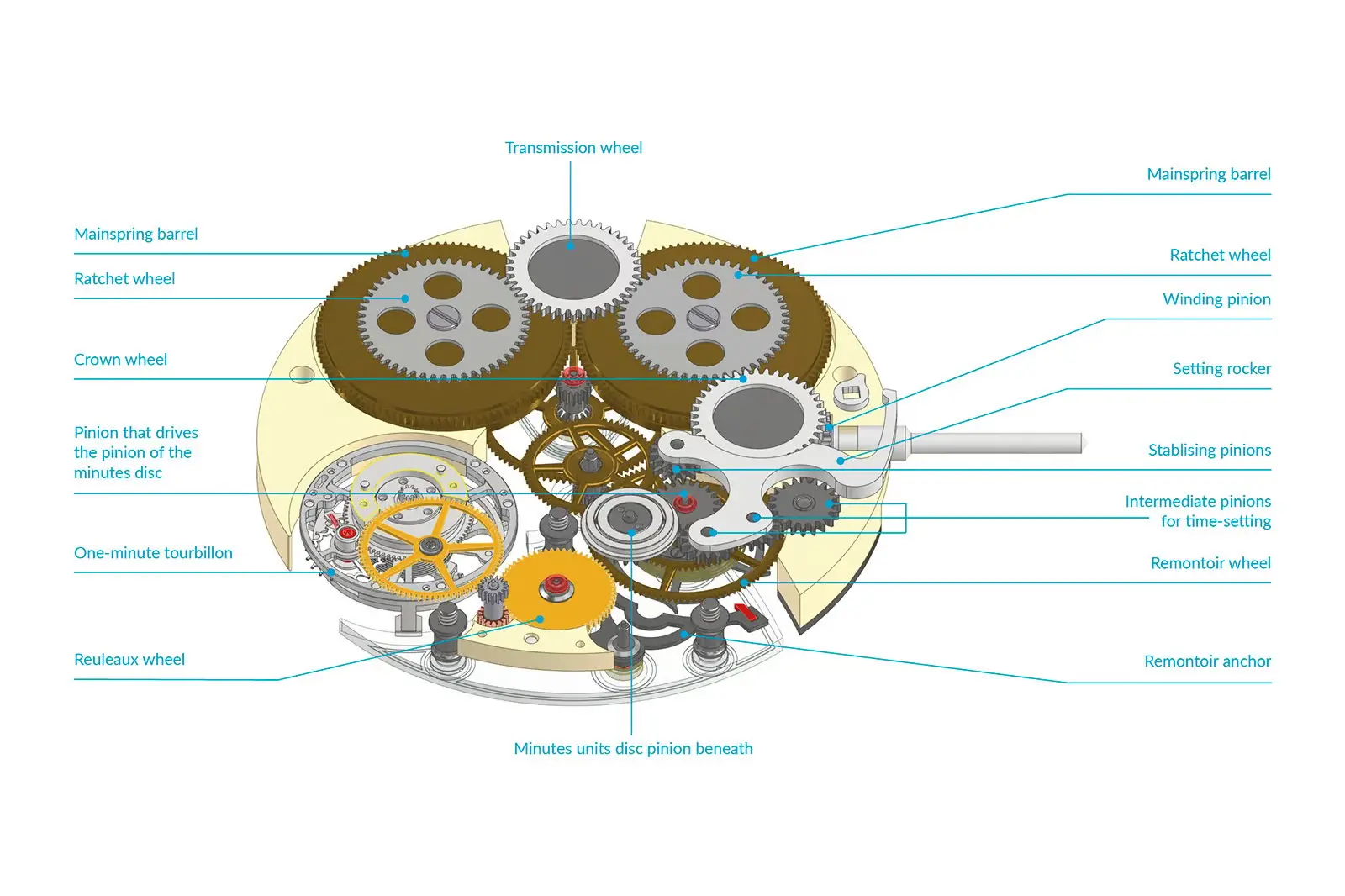
As before, the remontoir is located on the fourth wheel (third wheel in the gear train). The outer curve of the remontoir spring is pinned to a stud and fastened to a mobile stud holder on the ratchet stop wheel. The stud holder can be moved sideways to adjust the stiffness of the spring. The spring is wound by the gear train but is released only every minute by the advancement of the ratchet stop wheel.
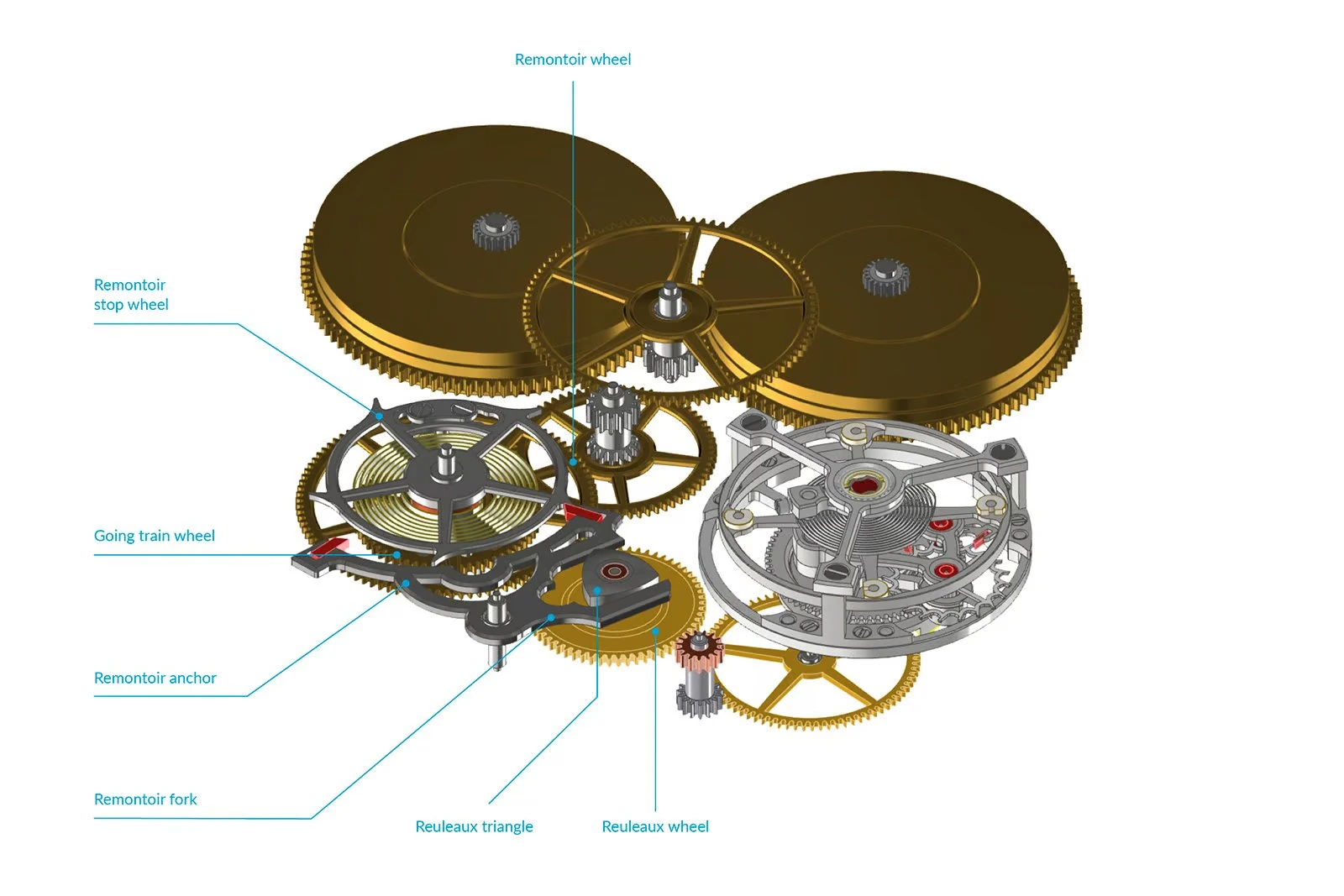
The stop wheel is unlocked by a pallet jewel on an anchor, which is connected to a fork. The motion of the fork is in turn governed by a Reuleaux triangle located on the fifth wheel. Thus, at every 60° turn of the Reuleaux triangle, the anchor unlocks one teeth of the stop wheel, releasing energy to the rest of the gear train until the second jewel pallet prevents the stop wheel from advancing further, thereby tensioning the remontoir spring once again. Beneath the fourth wheel on the same axis are two pinions – one pinion is fixed to the staff of the ratchet stop wheel while the second pinion is rotatably mounted.
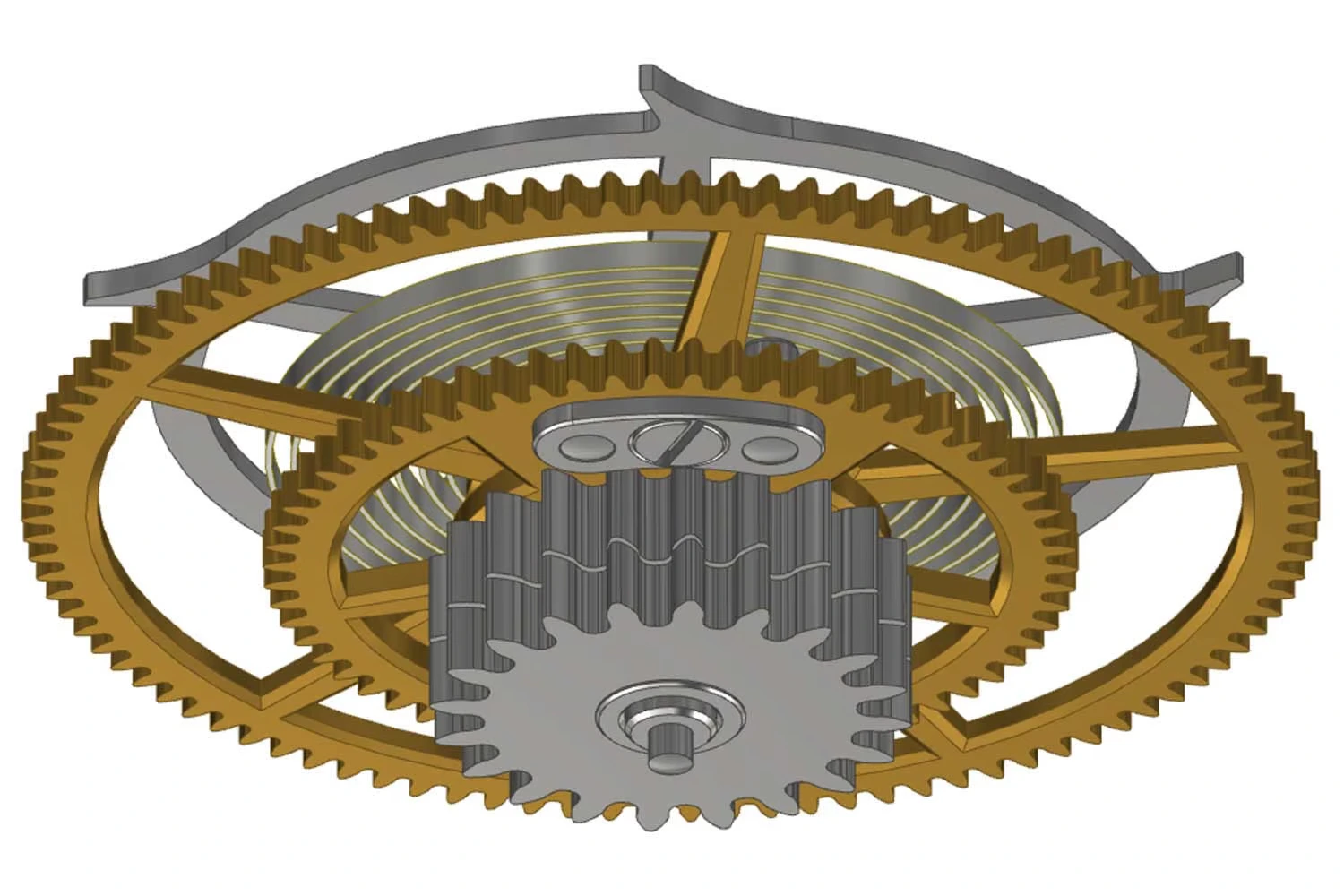
The most formidable challenge, aside from the intricacies of the complication itself, lay in the design of the keyless works. Due to the unconventional display that is powered by the remontoir, designing the keyless works, particularly the time-setting mechanism, proved to be far from intuitive. The team decided that the hours and minutes will be set in the first position and winding the mainspring barrels is achieved with the crown in the neutral position.
Mathieu arrived at an ingenious design that isolates the remontoir during time-setting. The time-setting mechanism has a rocker that carries a set of intermediate pinions — two on one end and a pair of superimposed pinions on the other. During the standard operation of the watch when the crown is in the neutral position, the superimposed pinions, which are fixed to a staff by a pin, meshes with the two pinions beneath the remontoir wheel, synchronising them to drive the pinion of the minutes disc.
But when the crown is pulled out to the second position to set the time, the rocker pivots and the superimposed pinions disengages from the pinions on the remontoir staff to allow them to rotate independently. At the same time, the other two pinions on the free end of the rocker is positioned to be driven by a third pinion, which is in turn driven through a series of gears by the intermediate winding wheel. The outer pinion drives the bottommost pinion on the remontoir staff, which in turn drives the pinion of the minutes unit disc, effectively isolating the remontoir.
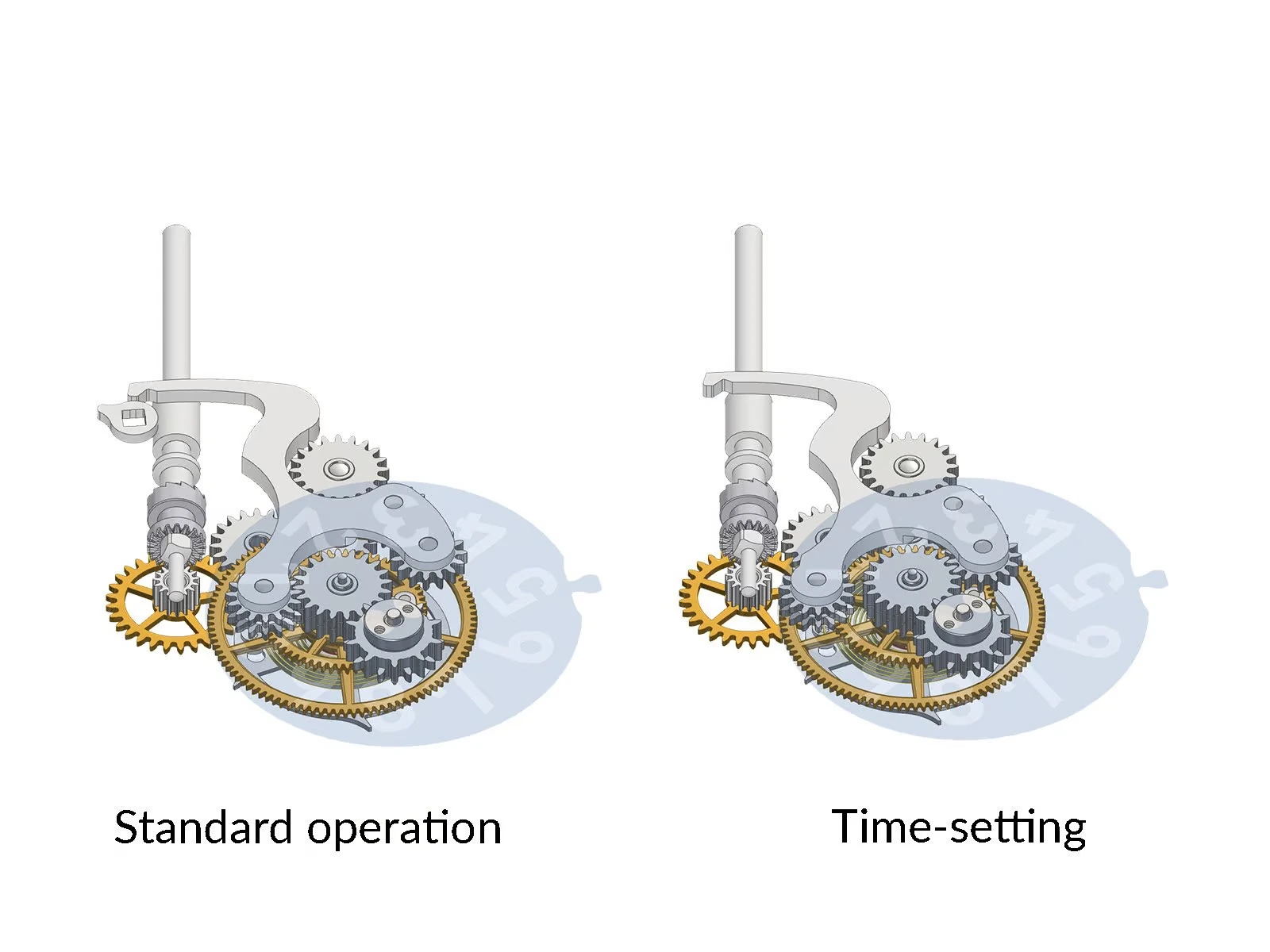
The jumping time display itself has also been refined. The pinion of the minutes units disc is driven by the pinion of the remontoir wheel, enabling it to leap forward at the top of each minute. Every 10 minutes, the finger on the disc advances a six-branch Maltese cross that is attached to a 60-minute intermediate wheel. It drives a smaller intermediate wheel at a 2:1 ratio, and affixed to this wheel is a cam bearing three equidistant raised hooks, functioning as fingers to incrementally advance the minutes tens disc. The minutes tens disc has been designed with 12 branches, which is necessary for controlled intermittent motion.
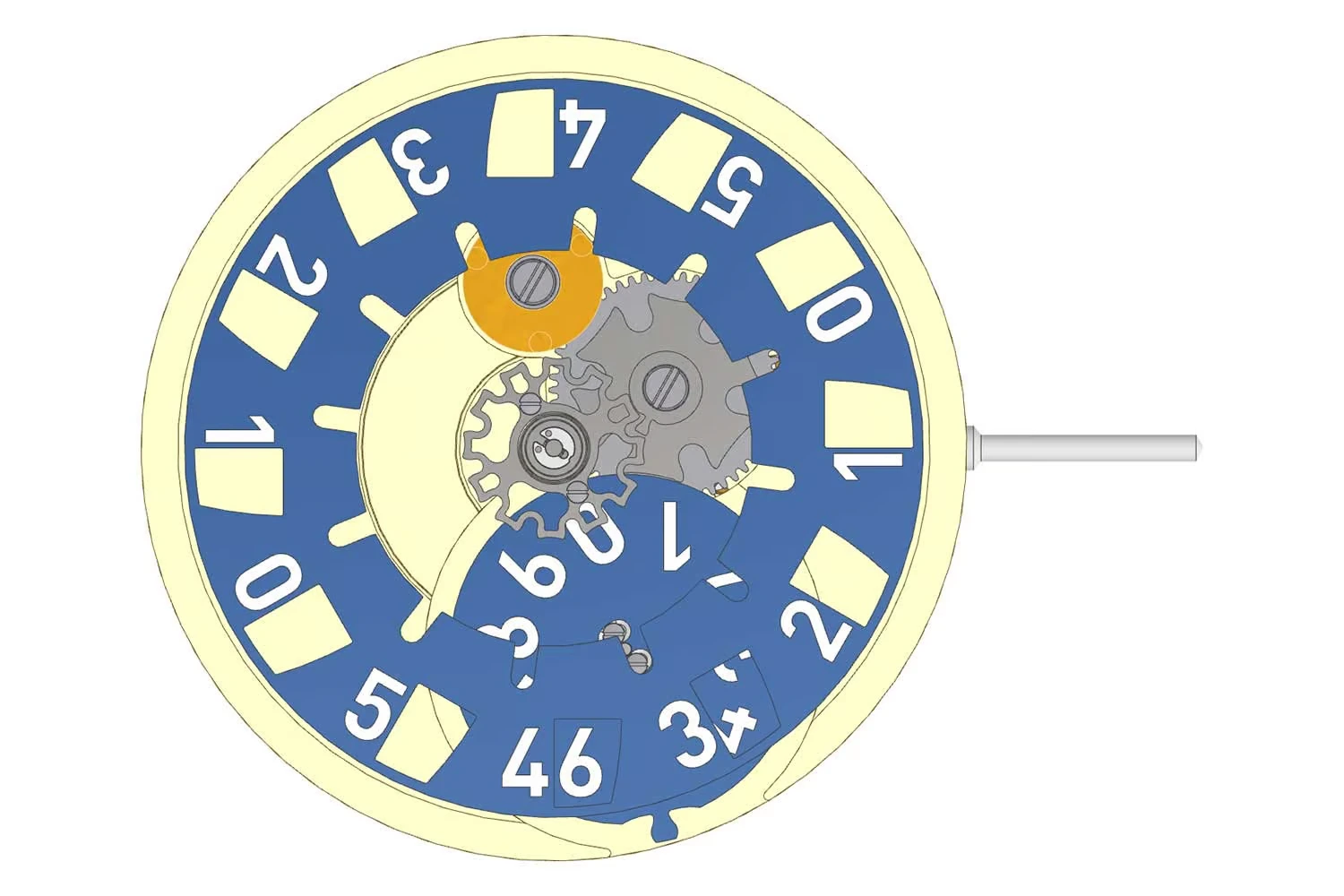
As the Maltese cross completes a full rotation in an hour, a finger piece advances a 12-branch Maltese cross, to which the hour disc is affixed. The hour Maltese cross now features a skeletonised design to reduce inertia.
Bridge design and finishing
The bridge layout has undergone a complete overhaul, resulting in a significantly more striking and exuberant movement. The new design is intended to showcase a variety of finishing techniques and to make as much of the components visible as possible. The base plate will be finished with frosting while its recesses will be decorated with perlage. The barrels are supported by a bat-shaped bridge, which is accentuated by a raised border that is straight-grained on its top surface and polished, bevelled on its outer edges. Its recesses, on the other hand, are frosted. It features large jewels that sit in deep, polished countersinks.
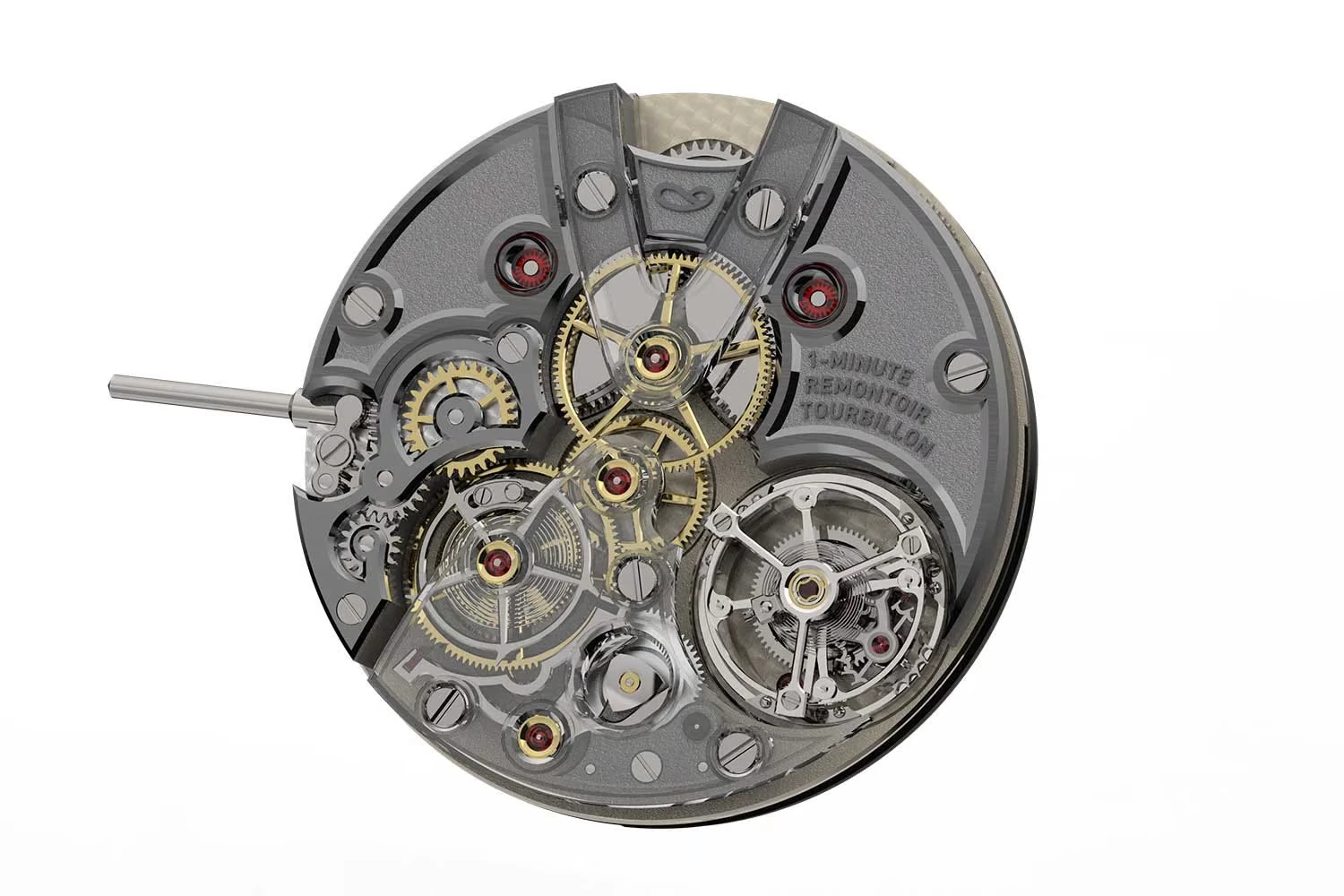
The second wheel is supported by a V-shaped sapphire bridge while the entire remontoir mechanism is left exposed beneath a larger sapphire bridge. Additionally, this larger bridge has an aperture, providing a clear view of the Reuleaux triangle in action. Notably, all the exposed wheels in the gear train, along with the remontoir stop wheel will have polished and bevelled spokes with sharp internal angles. Lastly, supporting the intermediate wheel and pinions in the keyless works on the left is a black-polished bridge of an intricate shape, which lends itself to a total of nine sharp internal angles.
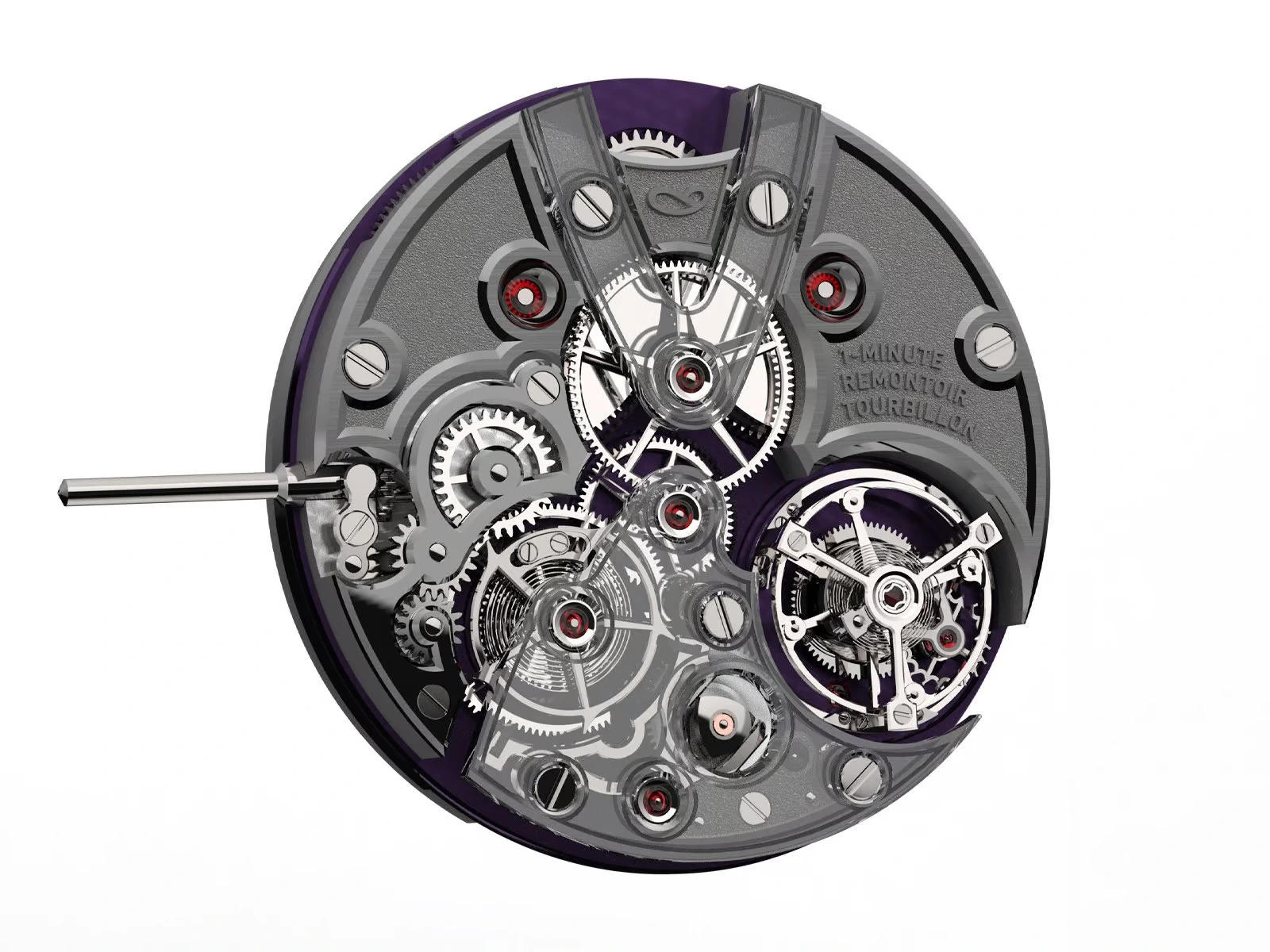
Dial design
Right from the outset, the movement was designed for the aperture of the jumping display to be positioned at six o’clock on the dial, which leaves the rest of the dial free to be embellished. Armand, however, decided to design another version of the dial for those seeking a touch of French flair. It features a cut-out that resembles the shape of a keyhole, providing a peek into the inner workings of the display mechanism. It enables a clearer view of the jumping action of the hour disc as the central hub is exposed. Additionally, the skeletonised Maltese cross behind the hour hub can also be seen engaging with a finger piece on the right.
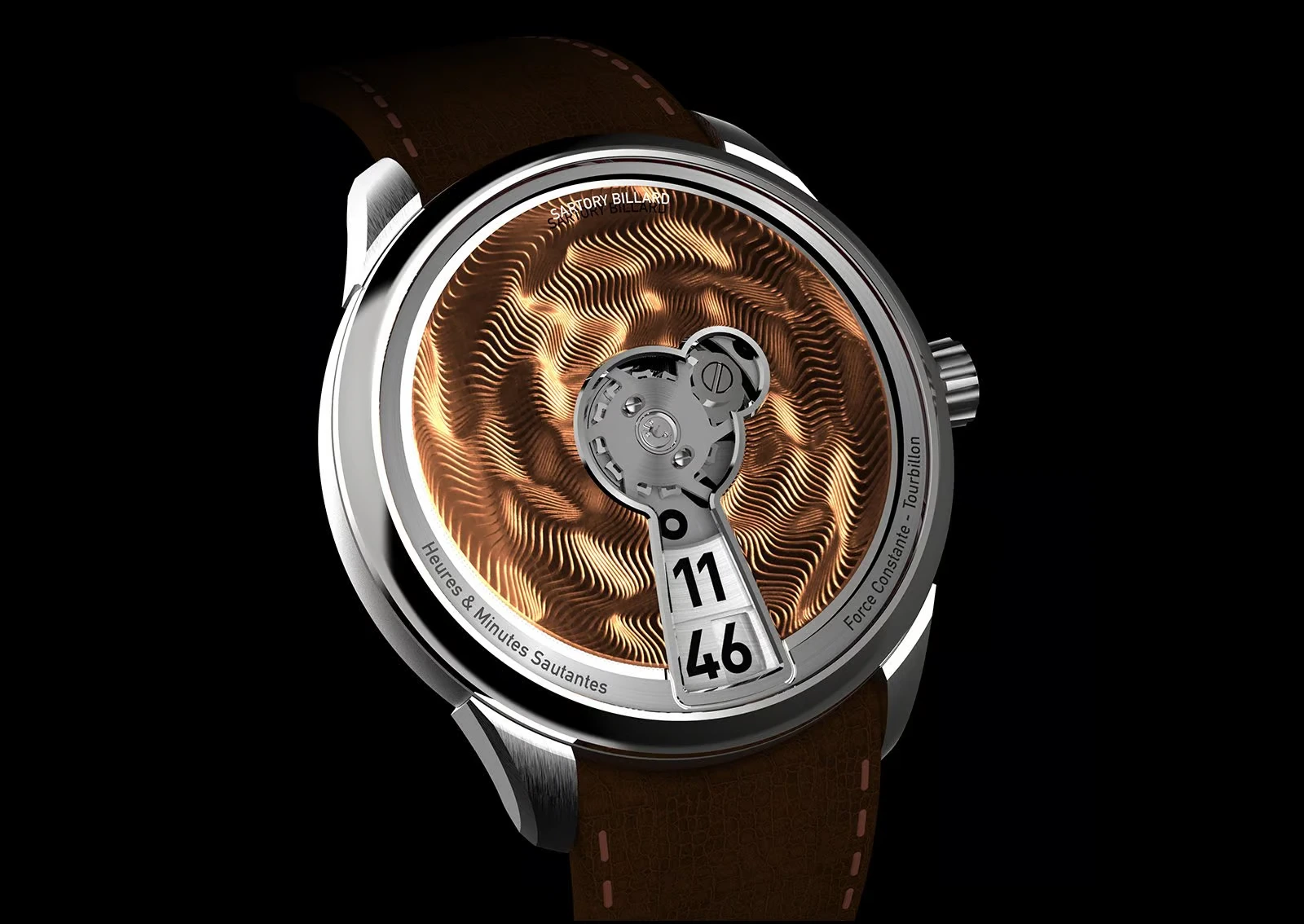
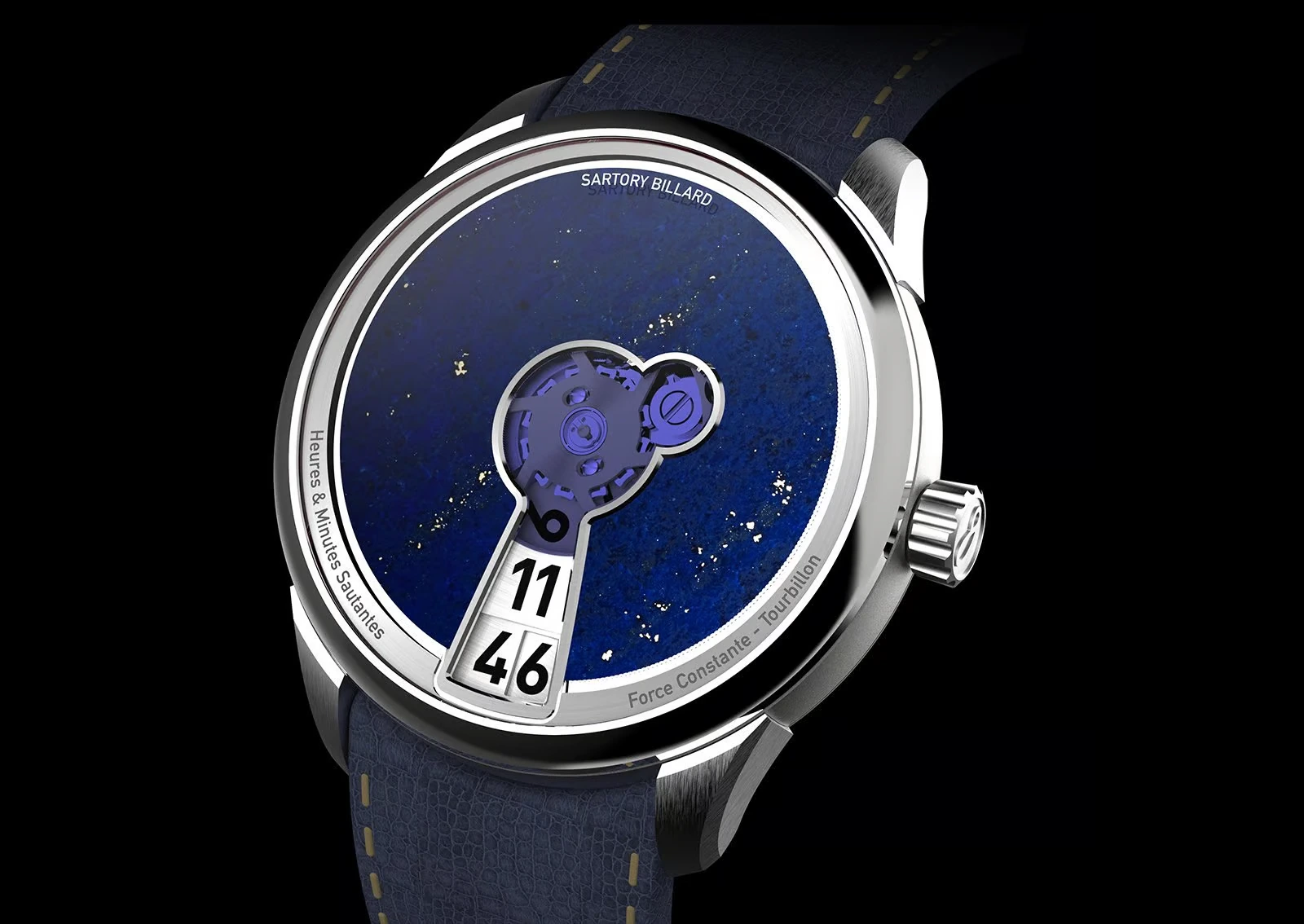
A nuanced yet impactful element that truly elevated the design of the dial was the addition of an elliptical metal border. It subtly draws emphasis to the digital display, contributing to a more refined appearance overall.
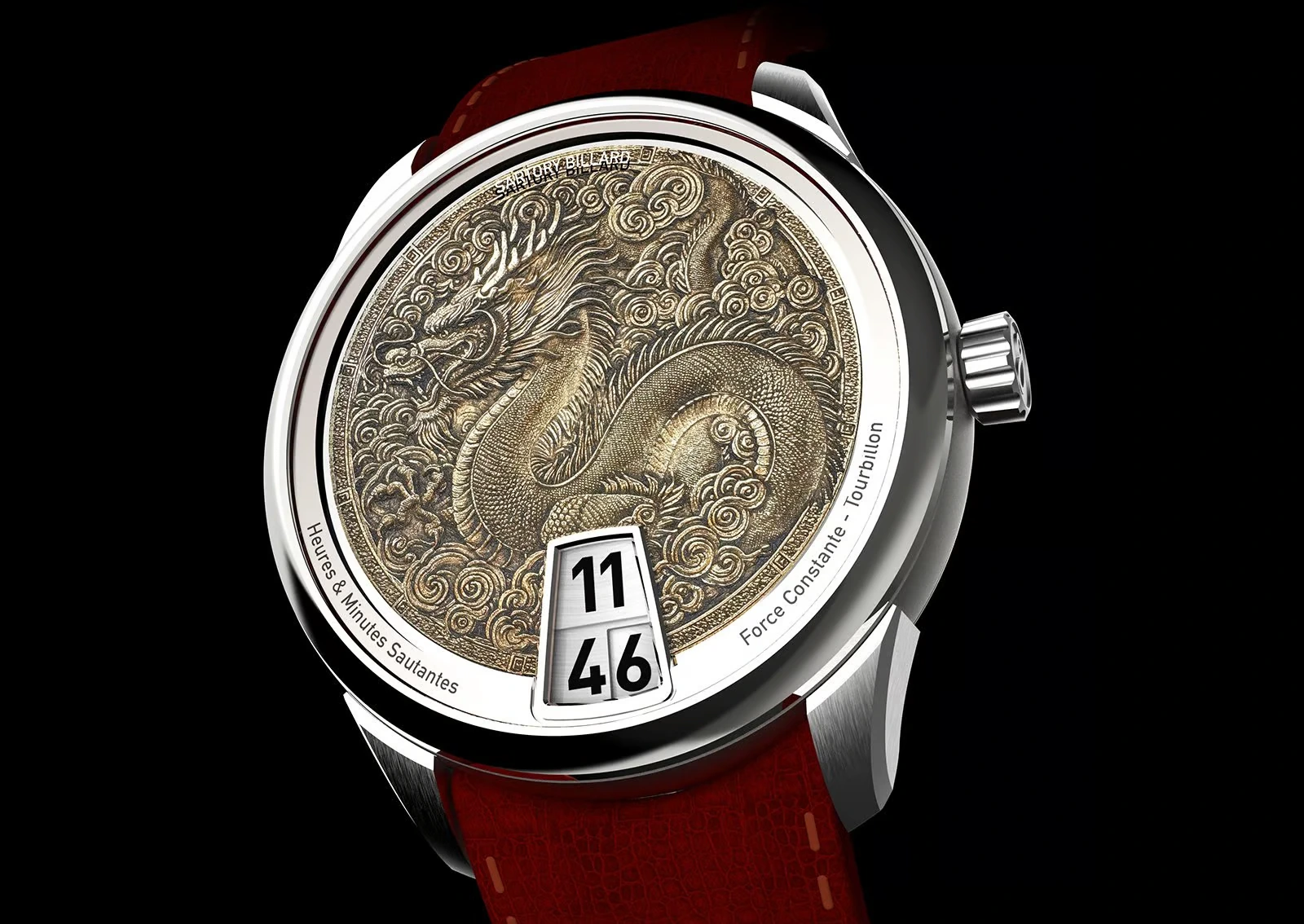
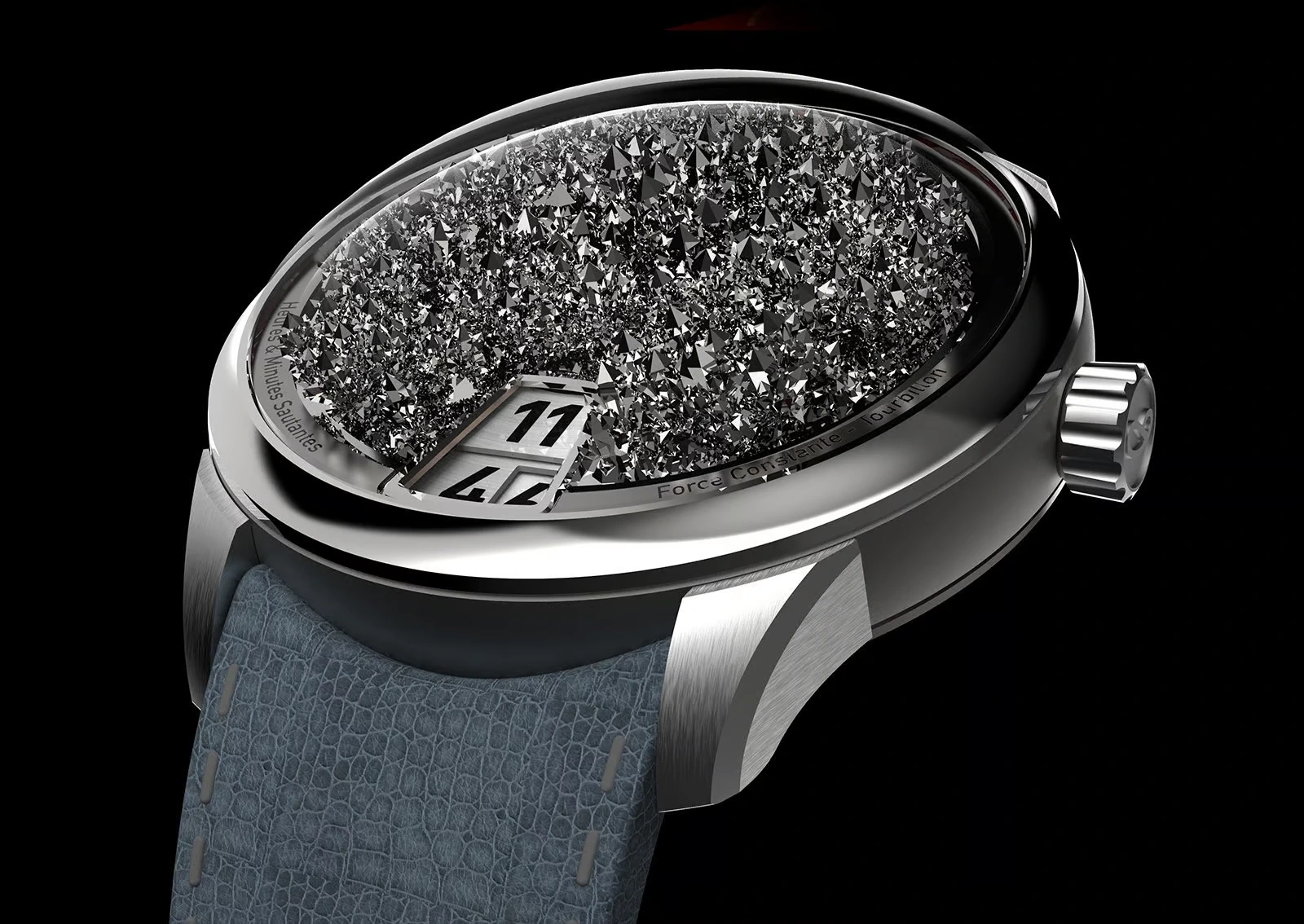
Armand and his team are progressing to the next phase of development, where they will consult with movement makers and specialists. Once again, they remain open to feedback and new perspectives along the way. For enquiries about the subscription series, please reach out to Sartory Billard through their official website.
Source : Revolution Watch Website
– https://revolutionwatch.com/sartory-billard-sb08-jump-hour-and-minutes-with-tourbillon/

